Cat Bauer's Blog
September 19, 2025
The Magic of The Venice Glass Week - "A Woman Is an Island" by Katia Margolis at Vert de Venise Art
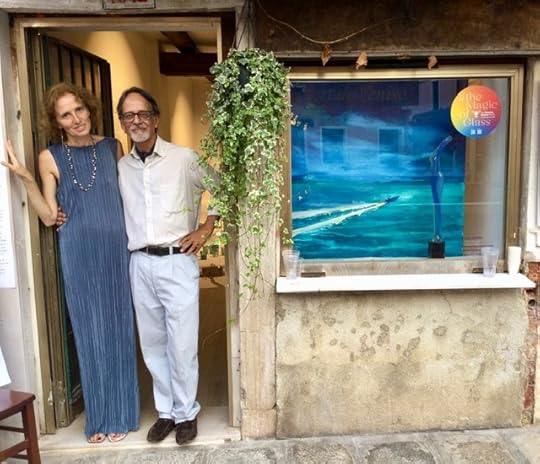 Katia Margolis & Robin Saikia, founders of Vert de Venise Contemporary Art
Katia Margolis & Robin Saikia, founders of Vert de Venise Contemporary Art Photo: Cat Bauer(Venice, Italy) The artist Katia Margolis captures the bluish green colors of Venice in every medium she touches, from canvas and paper to hand-painted silk dresses and scarves. So, it was only natural that she turn her talents to the magic of hand-blown Murano glass, an art that Venetians have practiced for more than a thousand years.
The Venice Glass Week is an international festival that supports and promotes the art of glass. Now in its ninth edition, the festival takes place in different venues around the historic center of Venice, the island of Murano, and Mestre on the mainland. There is a broad range of settings, from glass furnaces and galleries to museums and institutions, and over 200 events to visit.
This year, the festival is entitled #TheMagicOfGlass and runs from September 13 to September 21, 2025, though many of the installations will be open much longer.
You see people out on an adventure, wandering through the calli and campi of Venice, clutching colorful paper maps as they embark on a good old-fashioned treasure hunt for Murano glass marvels. For the digital among us, the map and program are also available online.
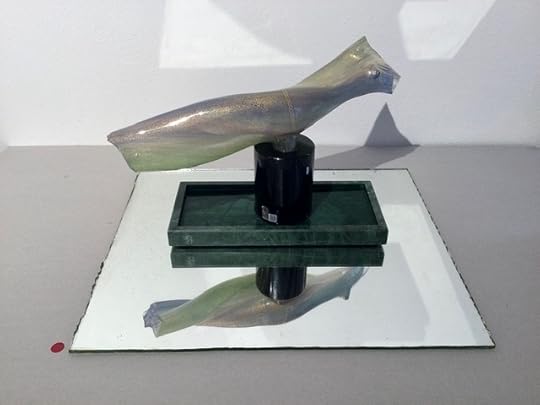 The Rebirth of Venice. Homage to Carlo Scarpa. Designed by Katia Margolis
The Rebirth of Venice. Homage to Carlo Scarpa. Designed by Katia MargolisGlass maestro: Oscar Zanetti
Photo: Cat Bauer
Vert de Venise Contemporary Art is an art gallery and open studio founded by Robin Saikia, Katia Margolis, and Leo Belo in 2024 that celebrates the beauty and traditions of Venice, and her role as a muse to her inhabitants and visitors.
Here is Katia Margolis in her own words about her project, A Woman is an Island :
My project for The Venice Glass Week 2025 explores glass as both material and metaphor -- fragile yet resilient, light and heavy, polished surfaces so easily broken into sharp edges -- qualities that reflect the contradictions of any human being. Women especially.
Working with Murano masters, I created female sculptures, glass "islands," and objects from discarded shards, transforming what was broken or abandoned into something new. For me, this act of reimagining is not only artistic but ethical: in a world fractured by war, violence, and injustice, vision itself becomes a battlefield.
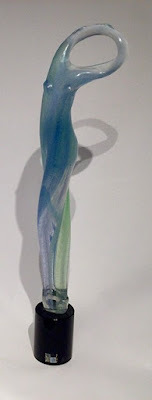
The exhibition, A Woman is an Island, reclaims John Donne's famous phrase in reverse. Each of us is an island -- not isolated, but uniquely outlined and open on all sides to the shared ocean. Freedom lies in choosing, despite vulnerability, to remain oneself, and to take responsibility. Through fragments, I seek a path to wholeness -- and to the future beauty.The aim of Vert de Venise is to build a bridge between traditional Venetian arts and crafts and contemporary art, a goal it achieves with A Woman is an Island. Katia Margolis lassoos the very soul of Venice herself from the surrounding sky and waters and hoists us up to the heavens.
Go to The Venice Glass Week for more information about #TheMagicOfGlass.Go to Vert de Venise Contemporary Art for more information about its projects.
Ciao from Venezia,Cat BauerVenetian Cat - The Venice Blog
September 15, 2025
A Glass Is Born in Venice
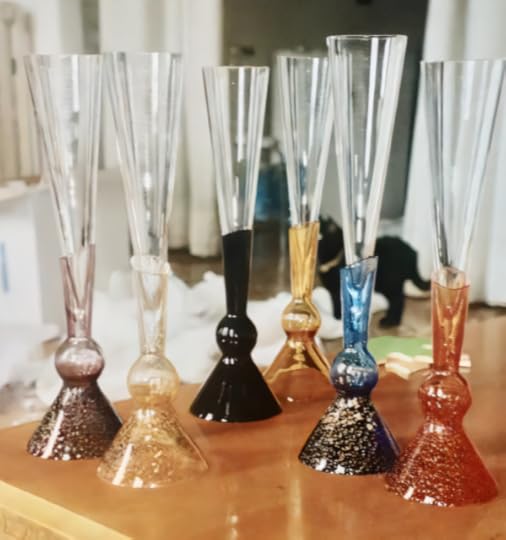 Murano glass flutes by Andrea Castione & Simone Cenedese - Photo: Cat Bauer(Venice, Italy) Venetians have practiced the art of glassmaking for more than a thousand years, a talent that has always fascinated me. To celebrate the ninth edition of The Venice Glass Week, I am republishing an article I wrote 24 years ago, way back in 2001, for Italy Daily, the Italian supplement of the International Herald Tribune.
Murano glass flutes by Andrea Castione & Simone Cenedese - Photo: Cat Bauer(Venice, Italy) Venetians have practiced the art of glassmaking for more than a thousand years, a talent that has always fascinated me. To celebrate the ninth edition of The Venice Glass Week, I am republishing an article I wrote 24 years ago, way back in 2001, for Italy Daily, the Italian supplement of the International Herald Tribune. It's interesting to see how much times have changed. Italy switched from using the lira to the euro by 2002. The Cold War ended around 1990, but it wouldn't be until 2007 that Romania became part of the European Union. Mercadanti has long been out of business. The Damiani Group became the owner of Venini in 2020.
But some crucial things have remained the same. In 2001, at age 27, Simone Cenedese was already one of the youngest glass maestros on Murano. Today, at age 52, Simone continues to work his magic on Venice's glass island.
Here is the original article, slightly edited:
A Glass is Born in Venice
Italy Daily Wednesday, February 21, 2001By Cat BauerSpecial to Italy Daily©Cat Bauer
Andrea Castione was so excited when he saw the prototype of his drinking glass brought to life by Murano master glassmaker Simone Cenedese that he ran to a nearby osteria at lunchtime to show a shopkeeper the results.
"Careful," the shopkeeper warned, tucking the work of art back in the box. "There's nothing but glassblowers in here."
Murano has always been a secretive island, about a ten-minute vaporetto ride from Venice, yet mysterious enough even to Venetians. Glassmaking traditions pass from father to son. Competition and copying are rampant. Feuds rage between different branches of the same family. The industry is of such importance that, in the past, a traitorous glassbower who revealed his secrets would be punished by exile or even death.
Mr. Castione's design -- the flute of the glass is separate from the base -- was unique on the island and had never been blown before.
Ferruccio Gheradi, owner of Mercadanti, a shop that sells original works at the foot of the Rialto Bridge, said, "I am Venetian. I was born here, grew up here, live here, work here. As soon as I saw this glass, I said, 'Finally. Something new.'"
In 1291, fear of fire moved Venetian glassmaking to the secluded island, where many of the factories remain today. During the Republic, the Doge of Venice granted special privileges to the Muranesi. They had their own "Golden Book," which listed the most important families, creating a local hierarchy that still exists informally today. Keeping the glassmakers cloistered on an island, swearing them to secrecy, and showering them with riches and titles of nobility practically guaranteed the Venetians control of the marketplace.
With all this in mind, Mr. Castione was hesitant to approach the island. Although his own Venetian roots date back to the 1600s, even a native like him has little cause to set foot on Murano.
"It's not like Burano or Torcello, where you go to have some fish, or maybe a stroll," he said. "You go to Murano for business."
But he loved the glass. As a child, he was taken by his father, an artist, to visit a factory where he saw a blower creating a vase. It was an image he never forgot. "There's something magical and pure about glass. It occurs naturally in volcanoes, on the beach -- when lightning strikes the sand, it creates long, thin tubes called 'petrified lightning.' But Murano is not the only place where they make glass. There are Venetians blowing glass on the mainland, too."
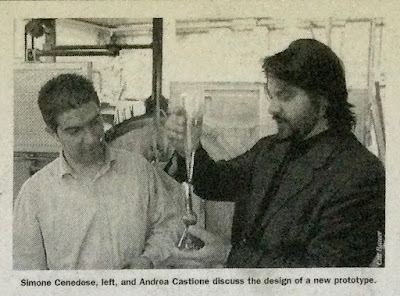 Simone Cenedese, left, and Andrea Castione
Simone Cenedese, left, and Andrea Castione discuss the design of a new prototype.
Photo: Italy DailyThe art of glassmaking is nearly as old as the Pyramids of Egypt. The tradition dates back about 3,500 years. The art of blowing the glass is a new concept -- about 2,000 years old -- and Venice one of its most respected centers. Over the centuries, the secret of what ingredients to mix together and in what quantities has been lost and rediscovered.
At the Venice Glass Museum on Murano, visitors can take a trip through the evolution of local glass. It is created by mixing a hodgepodge of ingredients, similar to the way a cook makes hard candy. The main element is silica, which the ancient Venetians dredged out of the Ticino River in the form of pebbles, then crushed. This was mixed with soda ash derived from plants, powdery marble, arsenic, and potassium carbonate.
The whole batch was heated until it melted and turned into a syrupy mass. When it cooled, it became glass. Today, the process remains much the same except that the furnaces are heated by natural gas, not wood, and the ingredients come from different localities. The tools themselves have been unchanged for centuries, dating back to the Middle Ages.
According to Mr. Gherardi, these days the island of Murano harbors another secret: A large percentage of the glass that is sold in the shops in Venice comes from Eastern European countries. In fact, it is not unusual for tourists to be pressured into taking a "free" tour of the island, complete with glass-blowing demonstration, only to find themselves corralled by high-pressure salespeople at the end.
"When I first started in this business, I had another little shop that sold the glass you see everywhere," said Mr. Gherardi. "I was surprised to find out that the representative I bought the glass from also sold glass to Murano! Many of those factories you visit where they give the demonstrations, surrounded by glass objects, well, that glass is coming from Eastern Europe, not here."
It all started when the Cold War ended, he explained, and Western Europe was suddenly open to its much poorer Eastern neighbors. "What does 20,000 lire buy in Venice? Not much. In Romania, you can feed your family with that."
Many major glass factory owners on Murano went to the East, opened factories there, and trained the Eastern Europeans in the art of making Venetian glass. "Except for Bohemia," Mr. Gherardi said. They have always had their own style, their own glass. But you can tell if a glass is blown or not. There will be little imperfections because it is touched by a human hand."
To English speakers, the word "factory-" conjures images of General Motors assembly lines, but an Italian fabbrica is often very small, with only a handful of employees, not capable of producing mass quantities of goods. Government controls are strict and expensive, and the price of materials and taxes is staggering.
"It's just not possible for most factories on Murano to produce the inexpensive glass you see on the street. Their costs are too high," Mr. Gherardi said.
Now that even the world-famous Venini glass factory is owned by Denmark's Carlsberg Breweries, are there any small, family-owned glass-blowing factories left on Murano?
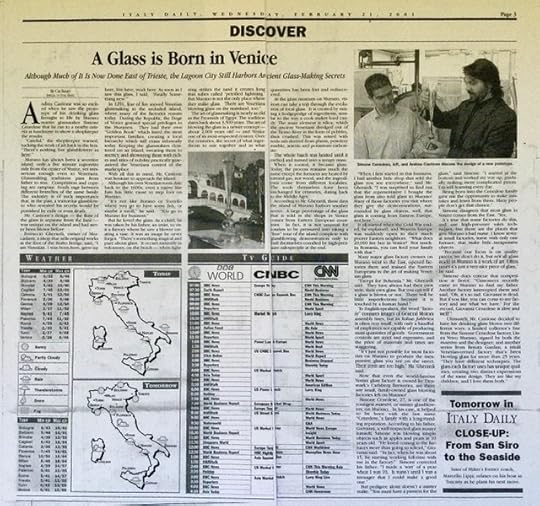
Simone Cenedese, 27, is one of the youngest maestri, or master glassblowers, on Murano. In his case, it helped to be born with the last name "Cenedese," a family with a long-standing reputation. According to his father, Giovanni, a well-respected glass master himself, Simone was blowing simple objects such as apples and pears at 10 years old.
"He loved coming to the furnaces more than going to school," Giovanni said. "In fact, when he was about 15, he started working full-time with me in the factory."
Simone corrected his father: "I made a 'sort' of pear when I was 10. It wasn't until I was a teenager that I could make a good one."
But pedigree alone doesn't a master make. "You must have a passion for the glass," said Simone. "I started at the bottom and worked my way up, gradually making more complicated pieces. I'm still learning every day."
Simone continued, "Being born into the Cenedese family gave me the opportunity to make mistakes and learn from them. Many people don't get that chance."
Simone disagrees that most glass in Venice comes from the East. "Yes, it's true that some factories do this and use high-pressure sales techniques. But those are the places that give Muarano a bad name. I know several small factories, some with only one furnace, that make little inexpensive objects."
"Because our focus is on quality pieces, we don't do it, but not all glass made in Murano is a work of art," he said. "Often times it's just a very nice piece of glass."
Simone does concur that competition is fierce. "Customers recently came to Murano to find my father. Another factory intercepted them and said, 'Oh, it's so sad. Giovanni is dead. But if you like, you can come to my factory and see what we have.' For the record, Giovanni Cenedese is alive and well!"
Ultimately, Andrea Castione decided to have his drinking glass blown two different ways: a limited collector's line from the Simone Cenedese factory, Linea Vetro Murano, signed by both the maestro and the designer; and another series from Renata Gardini, a small Venetian-owned factory that's been blowing glass for more than 25 years.
"They have different techniques. The glass each factory uses has unique qualities, creating two distinct expressions of the same design," said Mr. Castione. "They are like my children, and I love them both."
The Venice Glass Week 2025 runs from September 13 to September 21. Go to #The Magic Of Glass to discover the program.
Ciao from Venezia,Cat BauerVenetian Cat - The Venice Blog
September 5, 2025
Can "The Voice of Hind Rajab" Change the Course of History? Venice Film Festival 2025
 Palestinian girl Hind Rajab poses for a photograph in undated handout picture obtained by Reuters on February 10, 2024
Palestinian girl Hind Rajab poses for a photograph in undated handout picture obtained by Reuters on February 10, 2024 [Palestine Red Crescent Society/Family Handout via Reuters]
(Venice, Italy) Hind Rajab, a five-year-old Gaza girl, was murdered by Israeli forces moments after the ambulance sent to save her arrived. For hours, she had been trapped in a car at a gas station surrounded by the corpses of her aunt, uncle, and four cousins, who had already been killed by Israeli fire while fleeing Gaza City. When they arrived at the scene, the two ambulance workers were also murdered in cold blood.
We know this because Hind's terrified voice of a child pleading for help was recorded by the Red Crescent Society on January 29, 2024. The film, "The Voice of Hind Rajab," recreates the anguished conversation with actors playing the Red Crescent workers, reacting to the actual voice of Hind Rajab.
First, we hear Hind's desperate 15-year-old cousin, Layan Hamadeh, cry, "They are shooting at us. The tank is right next to me. We're in the car. The tank is right next to us." Layan screams as gunfire kills her as we listen. The Red Crescent calls back, and five-year-old Hind answers the phone.
For over three hours, the Red Crescent tried to coordinate a safe route with the Israeli military for the ambulance to travel as they tried to comfort Hind on the phone.
Three hours, when the rescuers were located only eight minutes away.
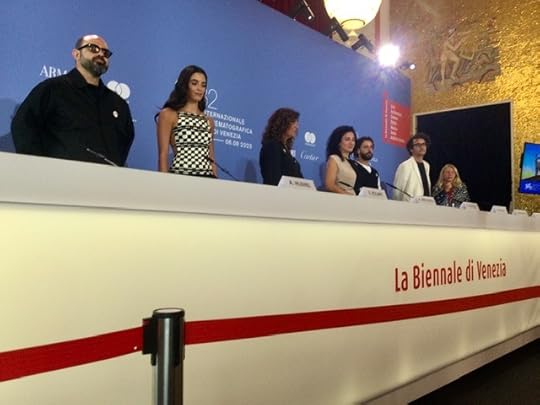 Director Kaouther Ben Hania and cast at "The Voice of Hind Rajab" press conference
Director Kaouther Ben Hania and cast at "The Voice of Hind Rajab" press conferencePhoto: Cat Bauer
The audience of journalists wept through the 90-minute screening of "The Voice of Hind Rajab" at the Venice Film Festival on Wednesday. During the press conference, we rose to our feet and applauded when Tunisian director Kaouther Ben Hania and the members of her cast entered the room.
At the public premiere later in the afternoon, the standing ovation went on for 23 minutes.
We applauded the courage it took to make the film and the bravery to present it to the world. We applauded the terrific performances. Personally, I've felt so helpless and frustrated about the genocide going on in Gaza that I applauded because somebody has finally done something to shock the world awake.
You feel sheer horror when you realize that Israel granted two Palestinian paramedics safe passage to travel by ambulance to rescue a five-year-old girl trapped for hours surrounded by army tanks and the corpses of her family, and then deliberately killed all three of them. Evil smacks you right in the soul.
A later investigation found that an Israeli tank had likely fired 335 rounds on the car that Hind and her family had been in. The ambulance appeared to have been run over by a tank.
Tunisian director Kaouther Ben Hania said she made a conscious decision not to let her actors hear the voice of Hind Rajab until they were actually filming. "It was a strong desire and the feeling of anger and helplessness that gave birth to this movie." The actors who played the real people in the Red Crescent Society said that hearing Hind's voice was more like a lived experience, not acting.
I hope "The Voice of Hind Rajab" changes the course of history. I hope the film wins the Golden Lion and is zapped with enough golden movie magic to penetrate the inertia that has paralyzed the planet as a genocide goes on while we try to live our everyday lives.
I hope "The Voice of Hind Rajab" is the impetus needed for humanity to join our voices with Hind's and scream, "Enough!"
Ciao from the Venice Film Festival,Cat BauerVenetian Cat - The Venice Blog
August 11, 2025
Not an Architect? 9 Personal Picks of the Venice Architecture Biennale 2025 for Curious Minds
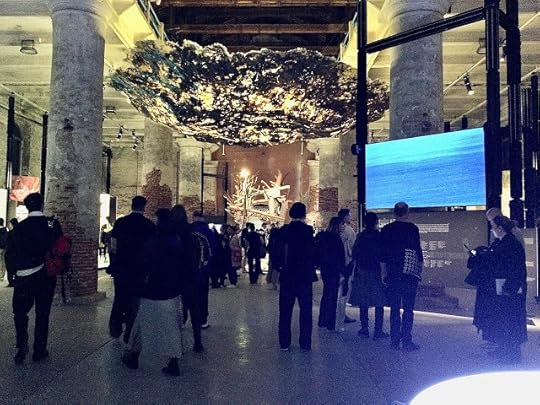 Intelligens Venice Architecture Biennale 2025 curated by Carlo Gatti
Intelligens Venice Architecture Biennale 2025 curated by Carlo Gatti Photo: Cat Bauer
(Venice, Italy) On May 8, 2025, I walked out of the Venice Architecture Biennale pre-opening press conference and into the spring sunshine. I judged that the line stretching down Ramo de la Tana to enter the exhibition at Arsenale to be a wait of at least a half hour. I frowned. What to do?
One of those pretty girl-art-groupies scooted over to me, waving a flyer. "Go visit Iceland's pavilion! It's right outside the entrance!" The flyer had the word "LAVAFORMING" scrawled across the top of a volcanic eruption.
I liked her style.
The Iceland Pavilion - Outside Arsenale
So, I found the Icelandic Pavilion, which I didn't even know existed (national pavilions that aren't permanent constructions in Giardini pop up in all sorts of places around Venice).
Inside, a film was already playing. I sat down just to kill some time, but the clever animation and compelling narration pulled me in:
"...According to local folklore, Iceland was inhabited with two populations -- humans (mannfòlk) and the hidden people (huldufòlk). The hidden people lived in rocks and cliffs, and only a few humans could see them or their prosperous and magically bright abodes and shiny halls.
After we mastered Lavaforming, people began wondering if this folklore had been a branch of the future that wandered off. A past memory of a distant future.
Iceland lies on top of one of Earth's great mantle plumes, channeled by the movements of the North American and Eurasian tectonic plates. Icelandic volcanoes frequently erupt and some are notorious -- such as Mt. Hekla, considered the gate to Hell in medieval times.
During a series of eruptions in 2021, known as the Reykjanes Fires, we had to monitor and understand the flow of lava, and eventually learn how to divert the magma away from critical infrastructures..."
 Lavaforming - Icelandic Pavilion
Lavaforming - Icelandic PavilionThe film went on to explain how molten lava can be harnessed as a valuable resource and used as a sustainable construction material to build everything from homes to entire cities.
I was confused. Was this fact or fiction? I knew Iceland had real volcanoes. I remembered when the Eyjafjalljòkull volcano shut down air traffic all over Europe back in 2010.
Architecture is such a difficult concept to convey to the average person -- all sorts of diagrams and mathematical equations and models that make your eyes glaze over. By using the storytelling skills of a novelist, the technical information was transformed into language a child could understand.I wanted to know if my theory was correct. I dashed around the pavilion trying to find someone who knew the answer until I stumbled on a woman with a microphone.
Sure enough, the author's name is Andrew Snær Magnason, one of Iceland's most prominent contemporary authors. He’s not only a novelist, he also writes plays, short stories, essays, and poetry. He's received the Icelandic Literary Prize in all categories: fiction, non-fiction, and children's literature.
Magnason also wrote an obituary for the first glacier Iceland lost to climate change.
 Geldingadalir, 2021 © Thrainn Kolbeinsson
Geldingadalir, 2021 © Thrainn KolbeinssonI wish more architects would use novelists to write their descriptions. One of the main complaints in the reviews I've read about this year's Architecture Biennale is how complicated and time-consuming the project descriptions are. There were QR codes, which I (and others) found annoying that utilized AI to condense the descriptions. I prefer the human touch.
The film Lavaforming takes place 100 years in the future, but the experiments to harness lava as a sustainable construction material are taking place in Iceland today. Created by Arnhildur Pálmadóttir and her team, I thought Lavaforming was one of the most exciting concepts at Architecture Biennale, so don't miss it.
First, Some Basics
 Necto, 3D knitted natural fibers by SO - IL, Mariana Popescu, and The Green Eyl - Photo: Cat Bauer
Necto, 3D knitted natural fibers by SO - IL, Mariana Popescu, and The Green Eyl - Photo: Cat BauerThe Biennale Architecture Exhibition is divided across two venues, Giardini and Arsenale. The Giardini was a public garden created by Napoleon in the early 1800s. The Arsenale was Venice's main naval shipyard where the Republic could crank out a ship a day.
You can walk from the exit of one venue to the entrance of the other in about 10-15 minutes. But once inside, both the Arsenale and Giardini are vast spaces that can be overwhelming.
Each venue is made up of two sections. One section is dedicated to the International Exhibition curated by Carlo Ratti titled Intelligens. Natural. Artificial. Collective. These projects are chosen by Ratti and follow his theme. This year there are more than 750 participants.
Normally the curator's projects are located in the Cordiere in Arsenale, and in the Central Pavilion at Giardini. But this year, the Central Pavilion is under reconstruction, so they're all jammed into Cordiere, and other venues around town.
The other section is dedicated to National Participations. These are installations presented by different nations across the globe. This year there are 66 National Participations -- 26 permanent pavilions at Giardini (Israel, Russia, and Venezuela are closed); 25 at the Arsenale, and 15 in the city center of Venice.
The National Participants can follow the theme of the curator if they want to, or they can do whatever they like. This year Ratti's theme seemed like it had a solid impact that influenced the projects of many nations.
ENTERING THE ARSENALE
The Third Paradise Perspective - Corderie
The 19th edition of the Venice Architecture Biennale -- the world's largest and most important event for architecture -- is summed up by these opening words of the curator, Carlo Ratti at the entrance to the Corderie, a vast structure -- more than 1,200 feet long -- where the Republic of Venice used to make rope for its ships:
When you step into the first room, that uncharted terrain smacks you right in the face. The room is dark. First, you are hit by the heat and humidity. Your eyes adjust. You realize you are surrounded by thigh-high pools of inky, black water. Air conditioning units and fans hang overhead. The path forward is not straight. You must walk around the edge of a circle.
Architecture has always been a response to climate -- an act of shelter, survival, and optimism. From the first primitive huts to the submerged foundations of Venice, human design has evolved in dialogue with nature.
Today, that evolution is no longer a choice but a necessity: climate change is not a future scenario, but a present reality.
We must adapt. Adaptation demands every form of intelligence -- natural, artificial, collective. Not individual genius, but collaborative insight. Nor rigid solutions, but flexible ecosystems.
In the face of an altered world, architecture must adapt itself -- venturing into uncharted terrain.
I was completely disoriented, and almost fell into the black water.
Now, after doing some research at Cittadellarte, it starts to make some sense -- the actual level of the thigh-high water in "The Third Paradise Perspective" installation is 70cm, the projected sea level in Venice by 2100.
In fact, once you understand some of the thought behind the opening room, then Carlo Gatti's title for the entire architecture exhibition -- Intelligens. Natural. Artificial. Collective. -- becomes clearer.
 Third Paradise
Third ParadiseItalian artist Michelangelo Pistoletto, a founder of the Arte Povera movement and creator of the non-profit Cittadellarte organization, turned 92-years-old in June. In 2003, he created the Third Paradise based on a reconfigured infinity sign.
What is the Third Paradise? Pistoletto explains:
It is the fusion between the first and second paradise.
As I've said, to me, Biennale Architecture always has difficulty in manifesting the architect's concept into something tangible that the average person with no background in architecture (like me) can understand.
The first is the paradise in which humans were fully integrated into nature.
The second is the artificial paradise developed by human intelligence to globalizing proportions through science and technology. This paradise is made of artificial needs, artificial products, artificial comforts, artificial pleasures, and every other form of artifice....
The Third Paradise is the third phase of humanity, realized as a balanced connection between artifice and nature. The Third Paradise is the passage to a new level of planetary civilization, essential to ensure the survival of the human race. To this purpose we first of all need to re-form the principles and the ethical behaviors guiding our common life.
The Third Paradise is the great myth that leads everyone to take personal responsibility in the global vision.
The term "paradise" comes from the Ancient Persian and means "protected garden." We are the gardeners who must protect this planet and heal the human society inhabiting it.
I wish I had had some knowledge of the "Third Paradise" before I visited the exhibition. Now, in retrospect, I think it was a intriguing idea to open the exhibition with the "The Third Paradise Perspective" -- if only the typical visitor knew what Pisoletto's symbol meant.
Sadly, only after the date had passed did I realize that I had been invited to the official presentation of "Scanno, Terzo Paradiso" on May 10th at Querini Stampalia, and would have had the opportunity to actually meet Maestro Michelangelo Pistoletto, as well as the crew from the Cittadellarte Pisoletto Foundation.
If you are planning to visit Biennale Architettura 2025, my advice would be to first brush up on Michaelange Pisoletto's the “Third Paradise." It holds the key to understanding Carlo Gatti's Intelligens. Natural. Artificial. Collective. Many other pavilions and projects (like Iceland) have variations on that theme as the foundation for their installations.
Am I a Strange Loop? - Corderie
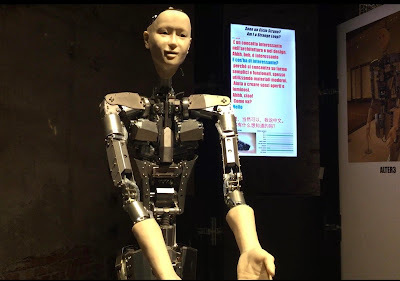 ALTER3 - Photo: Cat Bauer
ALTER3 - Photo: Cat BauerThere was so much chaos going on inside the Cordiere with 760 contributors(!) that the only project that stood out to my non-professional eyes was a creepy humanoid robot named ALTER3 that had no sense of humor. In the Am I a Strange Loop? installation you could have a conversation with it as it soaked up information about how humans behave when talking to a robot at an architecture festival.
I would like to witness the robot's behavior near the end of Biennale Architecture to see if it has become more humanized.
MORE NATIONAL PAVILIONS
The Holy See Pavilion - Venice Historic Center in Castello

The next day, before heading to Giardini where the permanent national pavilions are located, I went to have breakfast at the pavilion of the Holy See, which is based in the Ex Casa di Santa Maria Ausiliatrice, a complex that dates back to around the year 1171. Back then, it was a hospice that accommodated pilgrims on their way to the Holy Land.
The complex has undergone many transformations over the centuries. In 2001, it was sold to the Comune of Venice, which has some sort of agreement with the Holy See that allows the building to be restored and turned into a community center. All kinds of organizations are participating in the project curated by Marina Otero Verzier and Giovanna Zabotti.
During the six months of Biennale Architecture, the Holy See Pavilion will be repaired, reinvented, and revitalized with a special focus on young musicians. Feel free to stop by and see what they're up to.
The Qatar Pavilion - Giardini & Venice Historic Center at Accademia
 Qatar temporary pavilion, Community Center, designed by Yasmin Lari - Photo: Cat Bauer
Qatar temporary pavilion, Community Center, designed by Yasmin Lari - Photo: Cat BauerIn February of 2025, a few months before Qatar gave President Donald Trump a luxury jet to use as Air Force One, it was announced that Qatar would build a permanent national pavilion in Giardini. It was a bold stride onto the global cultural stage.
There have only been two permanent pavilions constructed in Giardini during the last 50 years -- Australia and the Republic of Korea. All together, there are 29 other permanent national pavilions in Giardini. The Qatar pavilion will bring the number up to 30.
Until the dust settles, right now there is a temporary Qatar pavilion on the site where the permanent one will go. I was curious to see what was going on so I stopped there first. I loved the energy from the moment I stepped inside.
I said, "This has female energy!"
The man in charge said, "You are exactly right. In fact, the woman who created the pavilion has just arrived. Come. I'll introduce you to her."
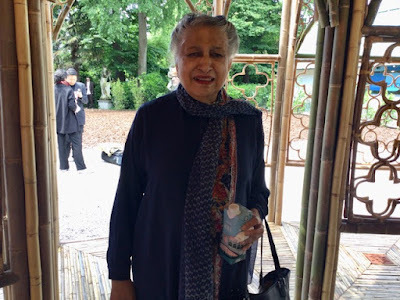 Yasmeen Lari, Pakistan's first female architect - Photo: Cat BauerAt age 84, Yasmin Lari is dynamic and inspiring. There's a phrase in Arabic, "Bayti Baytak," which translates to "My Home is Your Home," and that is what it the pavilion feels like. The temporary installation is a bamboo structure, created with bamboo that was sourced in Italy.
Yasmeen Lari, Pakistan's first female architect - Photo: Cat BauerAt age 84, Yasmin Lari is dynamic and inspiring. There's a phrase in Arabic, "Bayti Baytak," which translates to "My Home is Your Home," and that is what it the pavilion feels like. The temporary installation is a bamboo structure, created with bamboo that was sourced in Italy. Yasmin Lari is not from Qatar. She is Pakistan's first female architect, best known for using architecture for social justice. In 2023, she won the Royal Gold Medal for architecture awarded by the Royal Institute of British Architects in 2023.
For the design of her Community Center, Lari used techniques that she deployed as part of relief efforts prompted by the Heritage Foundation of Pakistan, an organization she co-founded in 1980.
Events inside the Community Centre throughout the duration of the Biennale Architettura 2025 focus on traditional Qatari forms of welcome, including the serving of coffee and dates.
I had the most delicious dates I've ever tasted, washed down with a delicious cup of coffee. In fact, I had two helpings. The fellow in charge of preparing the treat said he had tried to get dates from Italy, but couldn't, so he ordered them from Iran.
Remember, this was in May, before the 12 DAY WAR between Iran and Israel. I hope we can still get them!
The pavilion was commissioned by the 42-year-old Her Excellency Sheikha Al Mayassa bint Hamad bin Khalifa Al Thani, who is the Chairperson of Qatar Museums, and the sister of ruling Emir Tamim bin Hamad Al Thani.
The two-part exhibition explores how forms of hospitality are embodied in the architecture and urban landscapes of the Middle East, North Africa, and South Asia (MENASA).
The other and more formal part of Beyti Beytak is over at Palazzo Franchetti at the foot of the Accademia Bridge.
The permanent Qatar pavilion will be designed by Lina Ghotmeh, a Lebanese-born architect and founder of Lina Ghotmeh Architecture in Paris.
If the goal is to advance cultural diplomacy, Qatar is off to a good start.
The US Pavilion - Giardini
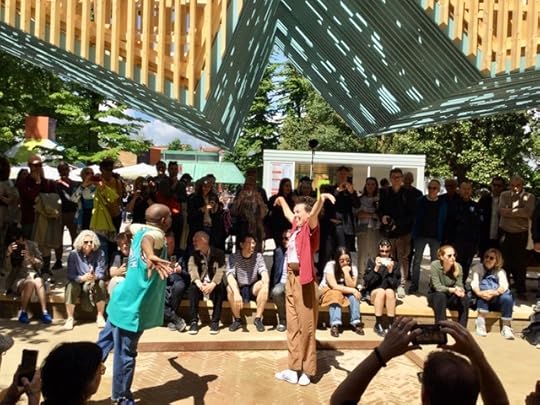 Folks having fun on The Porch at the US Pavilion during Biennale Architecture pre-opening
Folks having fun on The Porch at the US Pavilion during Biennale Architecture pre-openingPhoto: Cat Bauer
The first permanent pavilion at the Venice Biennale was, naturally, Italian, opened in 1895 in the presence of King Umberto I and Queen Margherita di Savoia. The next national pavilion was Belgium in 1907. Then came Hungary (1909), Germany (1909), Great Britain (1909), France (1912), and Russia (1914).
The countries built and owned the buildings. And then came World War I, and the Biennale was cancelled between 1916 and 1918.
The US Pavilion was built in 1930. It was privately owned, unlike other pavilions that were built by governments. According to the Peggy Guggenheim Collection:
In 1986, the Solomon R. Guggenheim Foundation, New York, purchased the US Pavilion from the Museum of Modern Art, New York, with funds provided by the Peggy Guggenheim Collection Advisory Board. Since 1986, the Peggy Guggenheim Collection has worked with the United States Information Agency (USIA), the Fund for Artists at International Festivals and Exhibitions, and currently with the Bureau for Education and Cultural Affairs of the US Department of State in the organization of the visual arts and architecture exhibitions at the US Pavilion. Prior to 2002 the architecture exhibitions were organized by the Solomon R. Guggenheim Foundation.The USIA was a US government agency devoted to propaganda. Although it was dismantled in 1999, it has an interesting history and has since morphed into other agencies. Throughout my years in Venice, the US Pavilion has remained active in trying to influence the global narrative.
This year, PORCH: An Architecture of Generosity was delightfully propaganda-free, unless the message was that Americans like to live life outdoor on their porches and watch the world go by. I grew up with a fantastic porch on our summer property in Upstate New York, so I loved the message, which was very Jimmy Stewart and Donna Reed.
During the pre-opening festivities, there was dancing and banjo playing and folk singing and kids swinging on porch chairs -- a welcoming atmosphere, full of good old-fashioned American charm.
The Austrian Pavilion - Giardini
 The Austrian Pavilion - Agency for Better Living - Photo: Cat Bauer
The Austrian Pavilion - Agency for Better Living - Photo: Cat BauerI was fascinated by the Austrian Pavilion. Did you know that most people in Vienna live in rented homes?
Since the fall of the Iron Curtain, Vienna has been growing rapidly. Yet life is affordable. Viennese social housing is a success story.
While the housing market in other cities has been handed over to the private sector, Vienna has chosen a different path. The city deliberately combats land speculation and produces affordable homes. Vienna still has enough land reserves for inexpensive social housing.
Today, the city faces new challenges like an aging population and increasing poverty. Here's a 2024 article from the Guardian that discusses both the good and the bad, The social housing secret: how Vienna became the world’s most livable city.
The second story examined by the pavilion is that of informal housing in Rome, which has produced unique forms of housing and living by reusing rundown buildings and other elements.
Agency for a Better Living imagines a future of better living for all with alternatives to speculative house building. I wish Venice would follow Austria's lead, and make more social housing available to its residents.
The Bahrain Pavilion - Arsenale
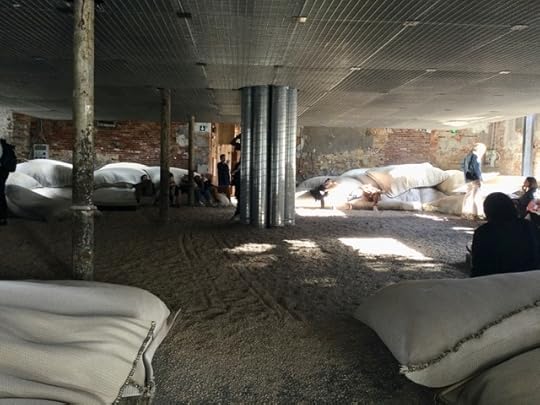 The Bahrain Pavilion - Heatwave - Photo: Cat Bauer
The Bahrain Pavilion - Heatwave - Photo: Cat BauerI had an extended pass, so I went back to both the Giardini and Arsenale after the Biennale Architecture Exhibition opened to the public. The atmosphere was much less hectic and intense. I was glad that I could spend more time at the installations, but I also missed the festivities and excitement that are part of the pre-opening crowds.
By then, the Kingdom of Bahrain's Heatwave had won the Golden Lion, the top prize for best national participation. I had just dashed through the installation before, so I went back to see what it was all about.
The "pavilions" inside Arsenale are not separate structures like they are in Giardini. You can drift from one space to another, not really knowing what pavilion you're in unless you make an effort to focus, which is sometimes difficult during the crowded pre-opening days.
The Bahrain Heatwave installation was designed to provide cooling in public spaces for people who work outdoors in places like construction sites. It's a modular unit with seating made of sandbags. There are detailed descriptions of how the system functions, which I'm sure is fascinating if you're an engineer, which I am not.
But I did enjoy lying on the sandbags and sharing the space with a community of other visitors, feeling the cool air on my face.
The Luxembourg Pavilion - Arsenale
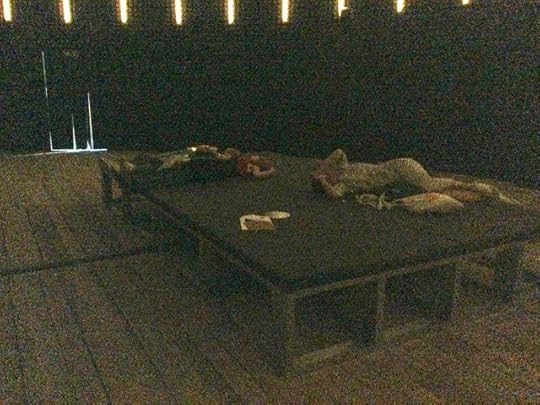 Luxembourg Pavilion - Sonic Investigations - Photo: Cat Bauer
Luxembourg Pavilion - Sonic Investigations - Photo: Cat BauerMy favorite pavilion turned out to the be last one. I almost didn't visit the Grand Duchy of Luxembourg Pavilion because it's located in Arsenale up an escalator in a separate structure apart from the Cordiere.
The above image would be completely black if I hadn't I cranked up the photo with every filter on my iPad.
Outside the entrance of the Luxembourg Pavilion, Sonic Investigations describes itself as "an immersive, joyful and radical invitation to shift focus from the visual to the sonic."
You enter a dark room. You can't see, and your eyes don't really adjust. After trying to figure out where you are and what you are supposed to do, you realize there is a large bed-like structure in the center of the room with people lying on it.
You fumble over. You lie down. Close your eyes. Slowly you realize that you not only hear sounds, you also feel vibrations.
"At the centre of the pavilion is a sound piece by field recordist Ludwig Berger. Entitled Ecotonalities: No Other Home Than the In-Between, the composition weaves together recordings from distinctive locations across Luxembourg."Instead of visiting the landscape of Luxembourg with your eyes, you visit it as a soundscape. It is an immersive space. A sonic experience. You hear whispers and sounds of nature and sounds of man and machines while feeling matching vibrations. Your imagination lights up and provides the visual images.
Sonic Investigations fulfills its goal and is: "an immersive, joyful and radical invitation to shift focus from the visual to the sonic." I could have stayed in there for hours.
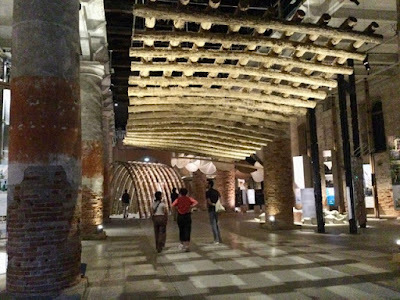 Inside Arsenale - Photo: Cat Bauer
Inside Arsenale - Photo: Cat BauerPractical Information
We are only about halfway through La Biennale di Venezia 19th International Architecture Exhibition, which will close on Sunday, November 23, so you have plenty of time to see it, or revisit it.
Pay attention to the opening hours:
The Venice Architecture Exhibition is always closed on Mondays in both venues, Giardini and Arsenale, EXCEPT on September 1, October 20, November 17.
Biennale Architecture 2025 is open on Tuesdays through Sundays from 11 am to 7 pm through September 28, EXCEPT at ARSENALE ONLY, which is open until 8 pm on Fridays and Saturdays.
From September 30 to November 23 opening and closing hours are an hour earlier. Both venues are open on Tuesdays through Sundays from 10 am to 6 pm.
Go to La Biennale for more information.
June 28, 2025
One Big Beautiful Billionaire Bezos Wedding in Venice
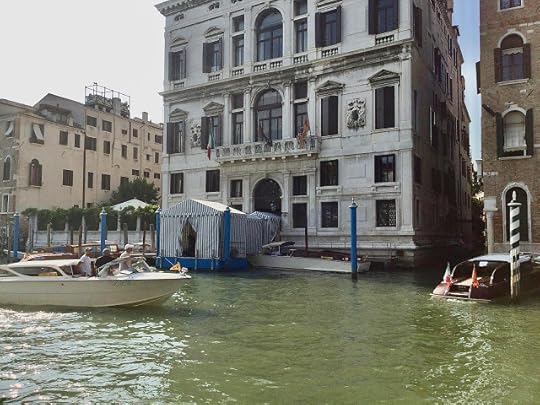 Bezos Wedding Base: The Aman Venice, set inside Palazzo Papadopoli on the Grand Canal
Bezos Wedding Base: The Aman Venice, set inside Palazzo Papadopoli on the Grand CanalPhoto: Cat Bauer(Venice, Italy) It is astonishing to witness the almost non-stop English-language news about the Bezos wedding unfolding right in front of our eyes here in Venice. The media has taken frenzied reports about the Bezos wedding to a new level and warped reality into something unrecognizable. You would think nothing else was happening on the planet these days (like the US bombing Iran's nuclear sites, war in Ukraine, genocide in Gaza, etc.).
Reality check: the average person walking the calli of Venice would not know there was a celebrity wedding going on. It is not impacting everyday life in Venice the way over-tourism and the lack of affordable housing does. Besides, everyday in life in Venice often includes yachts and celebrities arriving for events like the Venice Film Festival and the opening of the Venice Art and Architecture Biennale. Weddings take place every day in Venice -- getting married in the lagoon is the dream of many couples.
In 2014, the Clooney wedding took place in the same place as the Bezos wedding, at Palazzo Papadopoli. Instead of protests, a group of locals used the extra media attention to form the Unlock Your Love project. We went around Venice snapping off hundreds of "love" locks that ignorant tourists had attached to Venice's bridges.
In 2011, Lanza & Baucina, the same wedding planners that did the Bezos wedding, designed the billionaire Agarwal wedding, complete with elephant and Shakira, and no one said a word.
In 2009, Salma Hayek had her big second-wedding bash with billionaire husband François-Henri Pinault and a bunch of celebrities, including Bono. The week after, the then-Prince Charles and Camilla arrived, with Charles contemplating "living like a Venetian" for a time.
The point is that celebrities and dignitaries and billionaires arrive in Venice all the time, and it's been that way for millennia. In 1433, Cosimo de' Medici, one of the world's richest men, stayed in the Benedictine monastery on the very Island of San Giorgio Maggiore where the Bezos wedding took place. Medici was so rich that he was credited for kickstarting the Renaissance.
And Jakob Fugger (1459-1525), also known as Jakob the Rich, came of age in Venice at the Fondaco dei Tedeschi. Fugger's wealth adjusted to 2015 was estimated to be around $400 billion. Fugger was so rich that he loaned the Vatican the money to build St. Peter's Basilica and the Sistine Chapel.
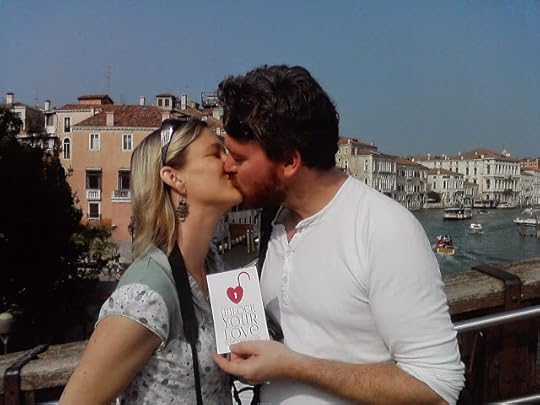 Random tourists kiss for Unlock Your Love project during 2014 Clooney wedding
Random tourists kiss for Unlock Your Love project during 2014 Clooney weddingPhoto: Cat BauerLast week, before the Bezos wedding, a few small groups of anti-Bezos protestors with handmade "No Space for Bezos" banners gathered to protest something -- I was not sure what, and I don't think they were, either. The handful of protestors were suddenly splashed across the international news as if there was a major upraising in Venice. It was blown up all out of proportion, and seemed very weird.
A few days later, the locals were joined by professional outside activists, who know a good protest opportunity when they see one. The outsiders brought professional banners to promote their own causes. The media mistakenly reported that those outside protestors were locals, which they were not.
When I told one Venetian woman, a hotel owner, I was going to write something about the wedding, she said, "Tell them that Venetians are used to aristocrats shopping next to them at the market. After the flood in November 2012, everyone helped each other, rich and poor. I don't know a single Venetian who agrees with the protestors. They are only two people and basta. We don't care."
Personally, I think there is plenty of space for Bezos, and I am glad that lagoon is still a crucial spot on the global chessboard. Venice knows how to host popes and emperors, kings and queens, sheiks, high-level forums, and G7 summits. A bunch of billionaires already own a bunch of property here.
And you can visit the wedding venues on your own, you just couldn't barge into the Cini Foundation during the wedding celebration. But you can't barge into the Cini Foundation during many private occasions.
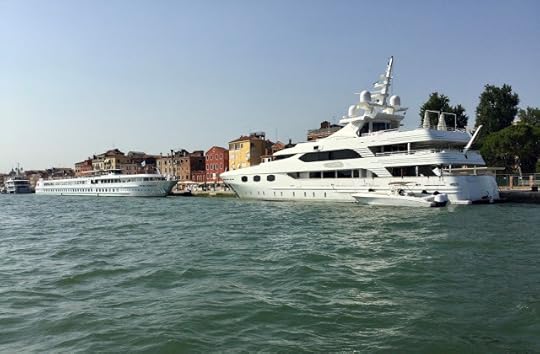 Michelangelo river boat & Were Dreams yacht in Venice lagoon
Michelangelo river boat & Were Dreams yacht in Venice lagoonPhoto: Cat BauerI think yachts liven up the lagoon and am happy to see them here. And it is not true that the yachts have taken up all the berths. Docked in front of the Were Dreams yacht was the riverboat Michelangelo, which you regulars will remember was slammed by the massive MSC Opera Cruise ship five years ago back in June 2019. Now, the Michelangelo is back in business, fully recovered, and the cruise ships are no longer barrelling down the Giudecca Canal.
In fact, I've always supported the No Grandi Navi movement and Tommaso Cacciari, one of the protest leaders, as did masses of locals. I first covered the No Grandi Navi protests back in 2012, which felt organic and true. Back then there were real outside forces that latched onto the protests and tried to create division in Venice.
These days, Cacciari seems to be part of the No Space for Bezos protests, which, to me, seem forced and manufactured. Again, I feel that Venetians are being used by outside forces. I mentioned this to a prominent Venetian Friday evening at a local event, and he said that he agreed and could not wait for the wedding to be over. The anti-Bezos protestors claimed victory when one of the wedding venues was changed from the Scuola Grande della Misericordia to Arsenale. The protests may have had something to do with it, but I don't think that was the main reason for the venue change.
On June 22, 2025, the US bombed three of Iran's nuclear sites as part of the Iran-Israel war.
In response, on June 23, Iran launched missiles at the US military base in Qatar.
Did you know there are two military bases about an hour outside Venice? The US Army Garrison is in Vicenza, and the US Air Force base is in Aviano. Fun fact: B61 nuclear bombs are stored in underground storage systems inside aircraft shelters at Aviano.
On June 23, the wedding venue was changed from Misericordia to Arsenale, which, to me, is a much nicer (and safer) location. The ancient shipyard is funky and full of life because La Biennale is always doing something inside the space, like dance, theater, and music performances. It converts to a press room during Art and Architecture openings. In fact, last year, Diane von Furstenburg had her DVF Awards at Arsenale, complete with excellent dinner -- I ran into Oprah Winfrey and Gayle King in the ladies room!
On June 25, the Bezos wedding guests started arriving, including President Trump's daughter, Ivanka Trump, her husband, Jared Kushner, and their three children.
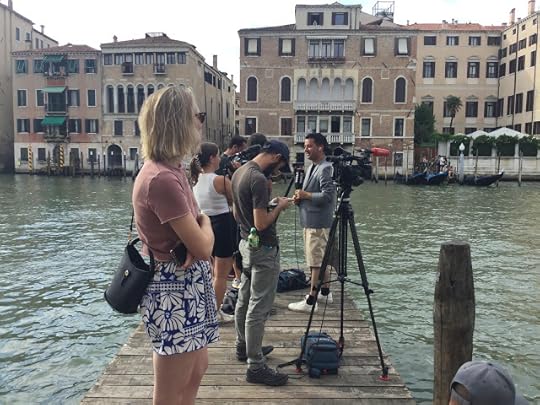 Media covering Bezos wedding - Photo: Cat BauerI was curious about the reason for the global frenzy, so I visited some media people (not paparazzi) who were set up across the Grand Canal from Palazzo Papadopoli, where the Bezos are based. I asked a fellow with a mike where he was from.
Media covering Bezos wedding - Photo: Cat BauerI was curious about the reason for the global frenzy, so I visited some media people (not paparazzi) who were set up across the Grand Canal from Palazzo Papadopoli, where the Bezos are based. I asked a fellow with a mike where he was from."Germany. Where are you from?"
"I'm American, but I live here. I'm a writer. Why are you here? Why all the media attention?"
The fellow chuckled. "Good question. They sent me here for three days and put me up in a very nice hotel, which is not cheap. This is not something that I usually cover. I'll talk to you in a second because right now I'm going on air and need to focus."
I waited.
After a few minutes, he took a breath. "They're coming back to me so I still can't talk."
"Just two quick questions, and then I'll leave. How long ago did they give you this assignment?"
"A day, but that's normal."
"What do you usually cover?"
"The war in Ukraine. Bombing in Iran. Gaza. Stuff like that."
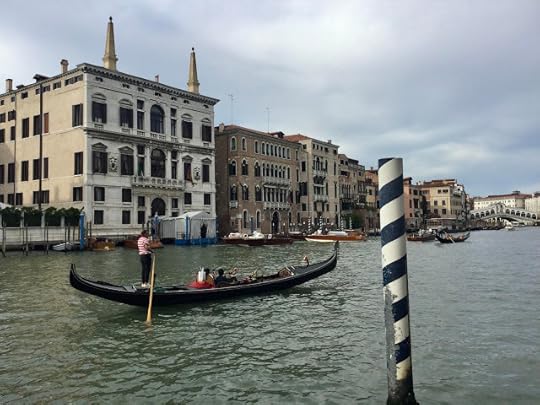 Aman Venice, prime location: Grand Canal at Rialto
Aman Venice, prime location: Grand Canal at RialtoPhoto: Cat BauerSomething I do agree with the protestors about is that Bezos has way too much money. That is not the fault of Venice -- it is up to the United States to regulate him. The US must change the laws so that one individual cannot accumulate so much wealth. Bezos must pay tax and give back to the country that made him billions. And not just Bezos...
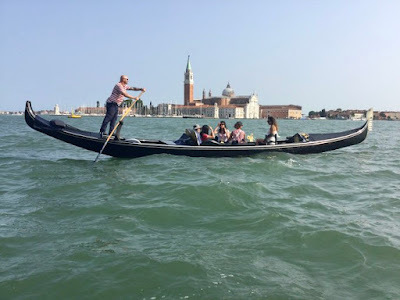 Gondola in front of Island of San Giorgio Maggiore
Gondola in front of Island of San Giorgio MaggiorePhoto: Cat BauerThe government of the Republic of Venice was ruled by an aristocratic oligarchy, a group of noble families, headed by a Doge. For the most part, they were extremely wealthy merchants and all had the same equal title of "Nobleman." The title was abbreviated N.H., Nobilis Homo for men, and N.D. Nobilis Domina for women.
The Venetian nobility not only set the rules for the Republic, they also kept each other in check. Legend says that the reason that gondolas are black was because they had become too ostentatious when families tried to outdo each other with their wealth.
From the book, Venice, A Documentary History 1450-1630, edited by David Chambers and Brian Pullan:
"English travellers were impressed by the tendency of Venetian...nobles to go in for conspicuous investment in building or parks, in things that lasted and could be kept in families, rather than for conspicuous consumption on clothing, feasting and large retinues of servants."
Since 1299, laws had been issued to restrain ostentation and lavish spending. By 1515, things had gotten so far out of hand that a special magistracy was created by the Venetian Senate to enforce them.
By 1562, wedding feasts themselves were regulated by the Venetian government.
"A MAGISTRACY TO ADMINISTER SUMPTUARY LAWS, 1515
It can be plainly seen, and it has come to our attention, that in the city of Venice there is much gross and unnecessary expenditure on meals and banquets, on the adornment of women, and on the decoration of houses, so that fortunes are squandered and a bad example is set to those who seek to live modestly. It is proper, therefore, especially in these hard times, to make every effort to put these matters right, and so do honour to the majesty of God."
"THE REGULATION OF BANQUETS, 1562
From a Senate decree of 8 October 1562
BE IT THEREFORE DETERMINED that, at nuptial feasts, at banquets for public and private parties, and indeed at any meal of meat, not more than one course of roast and one of boiled meat may be provided... Wild birds and animals, Indian cocks and hens, and doves shall be strictly forbidden... Oysters may be served only at private meals for twenty persons or less, and not at larger banquets or feasts..."
The impossible city of Venice was born over 1,600 years ago in the middle of a lagoon, the product of the powerful creativity and ingenuity of humankind.
I like to believe that the sacred majesty of Venice's architecture, built on the highest principles by enlightened beings, affects the souls those who visit. It's good for the spirit just to walk the twists and turns of the ancient labyrinth of Venice.
 Vintage Amazon Mouse Pad
Vintage Amazon Mouse PadAmazon was founded by Jeff Bezos and his then-wife, MacKenzie Scott, back on July 5, 1994, when the Internet was tiny and squealy. The majority of the public wasn't online, but writers were, and MacKenzie Scott was a writer. When Amazon was first starting selling books online back in 1995, many of its first customers were writers. We thought it was revolutionary and cool.
Amazon was so small back then that it gave a Christmas present to all of us who had bought a book that first year: a mouse pad with a quote by Groucho Marx:
Outside of a dog,
a book is man's best friend.
Inside of a dog,
it's too dark to read.
Groucho Marx
 Zaleti from Rosa SalvaWe were told by the media how Bezos had used mostly local businesses to execute the wedding, including goodie bags for the wedding guests from the Venetian pasticceria, Rosa Salva.
Zaleti from Rosa SalvaWe were told by the media how Bezos had used mostly local businesses to execute the wedding, including goodie bags for the wedding guests from the Venetian pasticceria, Rosa Salva. You know what I think would be a nice gesture of appreciation? If Bezos bought all the residents of Venice (less than 50,000) breakfast at any Rosa Salva in the historic center on July 5, the 31st anniversary of the founding of Amazon. Coffee, plus a certain selection of sweets, no takeaway. You must show your carta d'identità as proof of residency. Venetians enjoy Rosa Salva, too.
Ciao from Venezia,
Cat Bauer
Venetian Cat - The Venice Blog
May 28, 2025
"In Minor Keys" -- Koyo Kouoh Curates the 2026 Venice Art Biennale from Beyond the Grave
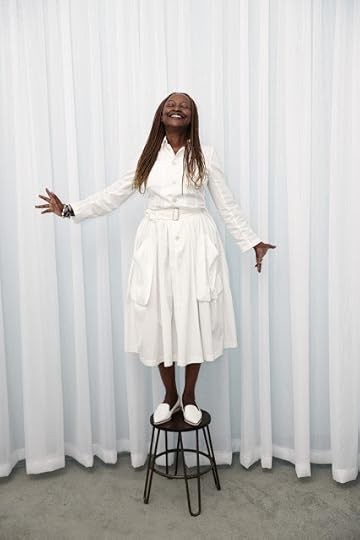 Koyo Kouoh - Photo: Mirjam Kluka
Koyo Kouoh - Photo: Mirjam Kluka(Venice, Italy) I was deeply moved by the beautiful and poignant presentation of Koyo Kouoh's In Minor Keys , the title of the 61st International Art Exhibition of La Biennale di Venezia, held on Tuesday, May 27, 2025 in Sala delle Colonne at Ca' Giustinian, headquarters of La Biennale.
On October 17, 2024, Koyo Kouoh accepted the invitation by Pietrangelo Buttafuoco, President of La Biennale, to become the Artistic Director of the Visual Arts Department for the 61st International Art Exhibition and curate La Biennale Art 2026. Her appointment as the first African woman to curate the Venice Art Biennale was publicly reported on December 3, 2024.
On May 10, 2025, Kouoh's sudden passing at the age of 57 due to recently diagnosed cancer was announced. The world of art and culture was stunned.
Just the week before, in an excellent Q&A with Charlene Prempeh of the Financial Times , Kouoh looked very much alive in vibrant photos by Trevor Stuurman. With prescience, she said:
“I do believe in life after death because I come from an ancestral Black education where we believe in parallel lives and realities,” she said. “There is no ‘after death,’ ‘before death’ or ‘during life.’ It doesn’t matter that much. I believe in energies—living or dead—and in cosmic strength.”Kouoh had nearly seven months on Earth to develop her curatorial project. She chose the profound and perfect title, In Minor Keys . The artists and artworks were selected, and her philosophical framework defined.
At the presentation on Tuesday, after an introduction by Biennale spokesperson Cristiana Costanza and President Pietrangelo Buttafuco, who said that Kouoh was "whispering from elsewhere," Kouoh's team took turns reading the text that she had sent to La Biennale on April 8, 2025. By the end, as the audience in the Sala delle Colenne rose to its feet, I had tears in my eyes.
 In Minor Keys - The Team: Siddartha Mitter, Gabe Beckhurst Feijoo, Marie Helene Pereira,
In Minor Keys - The Team: Siddartha Mitter, Gabe Beckhurst Feijoo, Marie Helene Pereira, image of Koyo Kouoh, Rasha Salti, Rory Tsapayi
Photo: Cat Bauer
The philosophical framework that guides Koyo Kouoh's curatorship is simple and divine. Here is the text, in her own words:
La Biennale di Venezia
61st International Art Exhibition
Curatorial Text by Koyo Kouoh
[Take a deep breath]
[Exhale]
[Drop your shoulders]
[Close your eyes]
This is an invitation to encounter these words in the immediate physical, meteorological, ambient,
and karmic conditions in which they meet you. To shift to a slower gear and tune in to the
frequencies of the minor keys. Because, though often lost in the anxious cacophony of the present
chaos raging through the world, the music continues. The songs of those producing beauty in spite
of tragedy, the tunes of the fugitives recovering from the ruins, the harmonies of those repairing
wounds and worlds.
There is a reason, after all, that some people wish to colonize the moon, and others dance before it as an ancient friend.
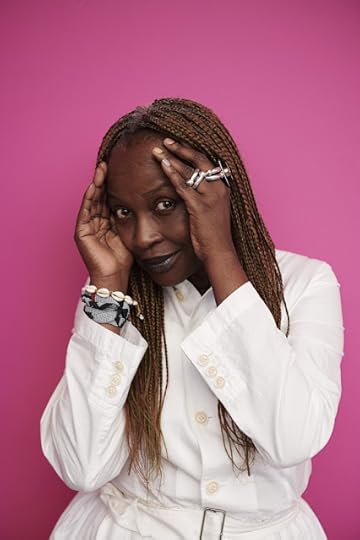 Koyo Kouoh - Photo: Mirjam Kluka
Koyo Kouoh - Photo: Mirjam KlukaThe minor key, in music, alludes both to the structure of a song and to its emotional effects. It is a
rich idea, so rich that it quickly overflows its technical definition and spills with metaphor. It
summons moods, the blues, the call-and-response, the morna, the second line, the lament, the
allegory, the whisper.
The minor keys refuse orchestral bombast and goose-step military marches and come alive in the
quiet tones, the lower frequencies, the hums, the consolations of poetry, all portals of
improvisation to the elsewhere and the otherwise. The minor keys ask for listening that calls on
the emotions and sustains them in return.
The minor keys are also the small islands, worlds amid oceans with distinct and endlessly rich
ecosystems, social lives that are articulated, for better and worse, within much larger political
forms and ecological stakes. Here, the evocation of the key and the island extends to an
archipelago of oases: gardens, courtyards, compounds, lofts, dance floors — the other worlds that
artists make, the intimate and convivial universes that refresh and sustain even in terrible times;
indeed, especially in terrible times.
Look at the creole garden, you put all species on such a little lick of land:
avocados, lemons, yams, sugarcanes …plus thirty or forty other species on this bit of
land that doesn’t go more than fifty feet up the side of the hill, they protect each other.
In the great Circle, everything is in everything else.
— Édouard Glissant, 1993
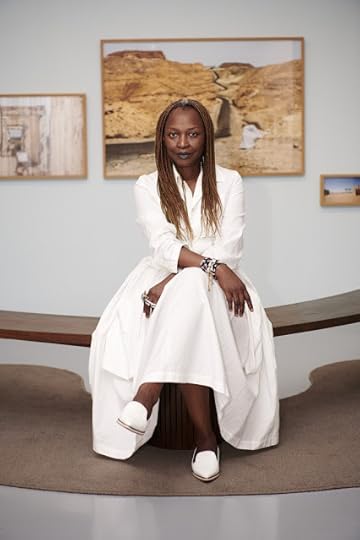 Koyo Kouoh - Photo: Mirjam Kluka
Koyo Kouoh - Photo: Mirjam Kluka
These are the cues for an exhibition; an exhibition tuned in to the minor keys; an exhibition that
invites listening to the persistent signals of earth and life, connecting to soul frequencies. If, in
music, the minor keys are often associated with strangeness, melancholy and sorrow, here their
joy, solace, hope, and transcendence manifest as well.
In the minor keys, sound and sensation are grounding, they hold the cadences, melodies, and
silences of resonant worlds that gather and create together a polyphonous assembly of art,
convening and communing in convivial collectivity, beaming across the void of alienation and the
crackle of conflict.
The 61st edition of the Biennale Arte is grounded in a deep belief in artists as the vital interpreters
of the social and psychic condition and catalysts of new relations and possibilities.
The exhibition’s composition is formed by artistic practices that open portals, that refresh and
nourish, that prompt relation and relationship, that advance concept and form through networks
and schools — understood freely and informally.
The intended effect scrambles cohesion and dissonance in the manner of a free-jazz ensemble, or
perhaps, at the scale of the Biennale Arte, a festival of ensembles with a common premise: that
poetics liberate and people make beauty together.
Through, relation, sharing, and transcendence, the artists and practices that operate in this spirit,
like jazz, across methods, scales, senses and forms, propose to visitors an exhibitional experience
that is more sensory than didactic, renewing rather than exhausting, and fortifying for the work
ahead.
Through a visual and meditative procession, the exhibition prompts all senses to interconnect and
meander from one universe to the other, rendering visible the possibilities that reside in the in-
between spaces and beyond the portals.
...there is no choice but to tune in like jazzmen to these imperative mutations.
The jazzman constantly meditates on the unpredictable, stands within it according to the
laws of polyrhythm, and improvises breathtaking moments.
We small-island Caribbeans are not ready, but we have this resource.
The change will have to be so profound that we will no doubt have to add to the knowledge of jazz, the
old totemisms, animisms, analogisms, and other metaphysics too summarily discarded.
These old-world poems are already precious scores.
— Patrick Chamoiseau, 2023
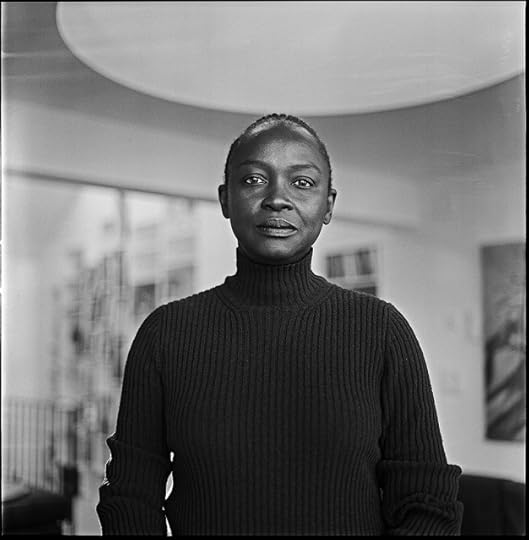 Koyo Kouoh - Photo: @Mehdl Berkler
Koyo Kouoh - Photo: @Mehdl BerklerIn this spirit, the international exhibition of the 61st Biennale Arte intends neither a litany of commentary on world events, nor an inattention or escape from compounding and continuous
intersecting crises. Rather, it proposes a radical reconnection with art’s natural habitat and role in
society: that is the emotional, the visual, the sensory, the affective, the subjective.
In Minor Keys are sequences of exhilarating journeys that address the sensate and the affective,
inviting visitors to marvel, meditate, dream, revel, reflect, and commune in realms where time is
not corporate property nor at the mercy of relentlessly accelerated productivity.
After all, it is clear by now that the enduring time of capital and empire maligned local,
Indigenous and terrestrial knowledges as chimeric, and dismissed co-constitutive artistic practices
as artisanal, intended for decoration or devotional rituals.
The ‘civilizing mission’ flattens all with condescending contempt, and in the contemporary era
entire societies and ecologies are regarded as collateral damage in the headstrong pursuit of
growth supported by ruthlessness and greed. In refusing the spectacle of horror, the time has come
to listen to the minor keys, to tune in sotto voce to the whispers, to the lower frequencies; to find
the oases, the islands, where the dignity of all living beings is safeguarded.
The exhibition posits that such radical shifts are taking place — indeed, have been underway all
along — in the minor keys, and the artists, poets, performers, and filmmakers whom the exhibition
will convene are grounded in their commitments to realizing them. Artists are channels to and
between the minor keys and listening to, rather than speaking for them is at the core of the
curatorial conceit.
The exhibition In Minor Keys stands as a collective score composed together with artists who have
built universes of imagination. Artists who work at the boundaries of form, and whose practices
can be thought of as intricate melodies to be heard both collectively and on their own terms. These
are artists whose practices seamlessly bleed into society.
Artists who accommodate daily life as part of a logical and aesthetically consistent relation of
parts. Artists who are exceedingly generous and hospitable to life.
In our myths, in our songs, that’s where the seeds are.
It is not possible to constantly hone on the crisis.
You have to have the love and you have to have the magic, that’s also life.
— Toni Morrison, 1977
1 James Baldwin, No Name in the Street (New York: Dial Press, 1972).
2 Edouard Glissant, Tout-monde (Paris: Gallimard, 1993), 208; translated by Eric Prieto, 2010.
3 Patrick Chamoiseau, 'We Caribbeans are not ready but have the resources to adapt to unavoidable
climate mutations,' Le Monde, June 29 2023.
4 Toni Morrison interviewed by John Callaway, WTTW, Chicago, 1977.
Ciao from Venezia,Cat BauerVenetian Cat - The Venice Blog
March 31, 2025
Silk Road Trip! 6 Venetian Merchants on the Silk Road in 1338 - From Venice to Delhi
 From Venice to Delhi - Photo: Cat Bauer
From Venice to Delhi - Photo: Cat Bauer(Venice, Italy) In the summer of 1338, six noble Venetian merchants took off on a life-changing road trip. They had formed a societas, or company -- sort of like an early form of a limited partnership -- and left Venice on a trading adventure. The plan was to travel the Silk Road until they reached the Sultanate of Delhi on the Indian subcontinent.
With global trade deals and tariffs blaring across today's headlines in 2025, it is important to remember that all this commotion about trading with foreign competitors is nothing new. As early as the 1300s, Venetian merchants had already formed trade companies to do business with Persia, India, and China. They had colonies in Constantinople and Crimea. (And yes, the head of the Venetian Republic was called the Doge:-)
If you know a bit about Venice, you will recognize the family names of members of the societas:Giovanni LoredanPaolo LoredanAndrea Loredan Marco SoranzoMarino ContariniBaldovino QueriniGiovanni Loredan organized the trip. The nobles had been to China before, hauling back a load of spices from the East, which they had exchanged for amber, and Flemish and Florentine woolen cloths. That first trip had been financed by an early version of crowd funding, with contributions coming from a wide range of people, including a group of Venetian women -- backed by Caterina, Giovanni's mother.
Now the noble merchants wanted to go to India to do business. Because of the nature of global trade, the goods and investments loaded in Venice were not necessarily the same as those that would arrive in Delhi. The continuous purchases and sales of goods would respond to the tastes and needs of the market the merchants encountered along the Silk Road. Caterina did everything she could to convince her son not to make the second perilous voyage.
But Giovanni could not be dissuaded. He believed a fortune would be made if they could reach the Sultan of Delhi, Muhammad ibn Tughluq, whose Sultanate ruled most of India. For the journey to Delhi, the partners had a common capital of 12,600 ducats, equal to more than 44 kg (97 lbs) of gold.
It was said that the Sultan would receive guests in the gigantic hall of the 'Thousand Pillars,' reclining on a raised throne covered with white carpets and cushions. Surrounding the Sultan were hundreds of nobles, courtiers, and soldiers, and harnessed horses and elephants. The Sultan was "famous for acts of great generosity but also for his extreme cruelty." If the Sultan liked the gifts bestowed upon him, he would respond by giving gifts worth three times their value in return.
So, in addition to other goods, Giovanni & Co. shrewdly brought with them the latest marvels of European technology: a mechanical clock and a mechanical fountain. Both gifts had been made in Venice by the goldsmith Mondino da Cremona, the go-to guy for gifts for world leaders. A few years earlier, da Cremona had sold a clock to the king of Cyprus for an impressive 800 ducats, equal to almost 3kg (6.61 lbs) of gold.
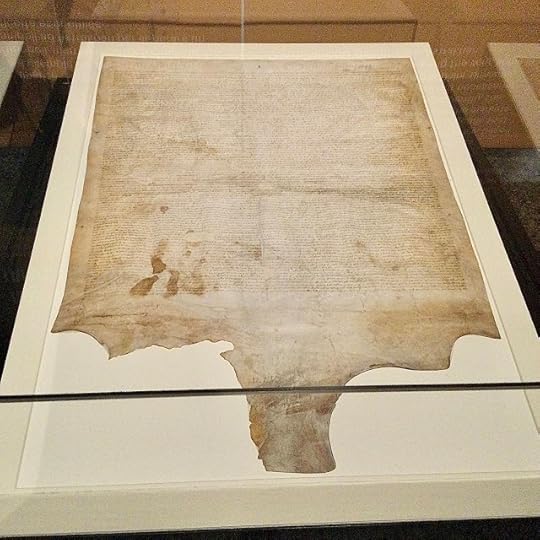 Parchment of the 1350 court case - Photo: Cat Bauer
Parchment of the 1350 court case - Photo: Cat BauerHow do we know all this?
The Archivio di Stato in Venice is one of the largest in Italy, and is located inside the former convent of Santa Maria dei Frari. Venetians were terrific about keeping written records. The Venice State Archive preserves more than 1000 years of Venetian history, covering about 80 km (50 miles) of shelves.
Hidden within the labyrinthine archives of Venice was a fragile 1350 parchment about a court case brought by Alberto de Calle against the heirs of his son-in-law -- who happened to be our protagonist, Giovanni Loredan.
The 14th century parchment had been found and forgotten in the State Archives decades ago, and had been lost for more than 70 years.. It was largely overlooked by scholars of Venetian history, and in very poor condition. Then, when the celebration of the 700th anniversary of Marco Polo's death in 2024 was approaching, historian Dr. Luca Molà remembered the parchment. Molà convinced the University of Warwick, where he is a professor, to fund the restoration of the document. The restoration allowed Dr. Molà and his colleague, Marcello Bolognari, to bring the ancient document -- written mostly in Latin with testimonies in Venetian vulgar dialect -- to life.
The 1350 parchment is the record of a long court case. It offers a rich glimpse into a pivotal moment in Silk Road history, and provides a rare insight into Venetian trade with Asia just years after Marco Polo's death in 1324.
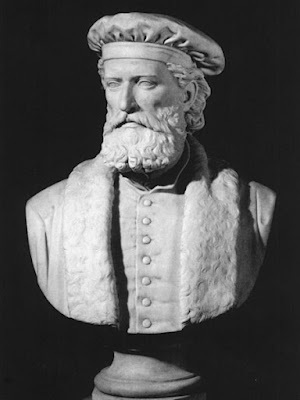 Bust of Marco Polo by Augusto Gambo (1862-63)
Bust of Marco Polo by Augusto Gambo (1862-63)Marco Polo, the Original Gangster
Marco Polo was the OG. The six noble Venetian merchants were continuing his journey into the exotic world of the East. In fact, Giovanni Loredan was a distant relative of Marco Polo's. All the other travelers were Marco Polo's neighbors in Venice.
Marco Polo wasn't the first European to make the journey to the East, but he wrote the best seller, Il Milione -- commonly known as The Travels of Marco Polo -- so he is the one we know the best.
Born around 1254 in Venice, Marco Polo came from a family of seasoned merchants. Details are murky, but apparently Marco's mother died when he was young, and he was raised by his extended family. His father, Niccolò, was one of three brothers who were also business partners. The eldest brother, also named Marco, was a resident of Constantinople; the youngest brother was Maffeo. All three made regular journeys to Crimea and beyond. While Niccolò and Maffeo were in Bukhara (Uzbekistan) in 1260, a center of trade on the Silk Road, they met messengers on their way to meet the great Mongol ruler Kublai Khan. The envoys persuaded the Venetians to accompany them to what is now Beijing. When they arrived, Kublai Khan -- who was a Buddhist -- was fascinated by what the Polos told him about Europe and the Christian religion. He sent them back West as his special envoys with a letter to Pope Clement IV requesting holy oil from the Church of the Holy Sepulcher in Jerusalem, where Jesus Christ was buried, and a 100 missionaries to instruct his people in Christianity. So, off went the Polo brothers. When they reached Acre, then the capital of the Kingdom of Jerusalem, they met with the papal legate, Teobaldo Visconti, who was representing the Pope in the Holy Land. The Polos found out that Pope Clement had just died and the election for his successor was embroiled in turmoil. Visconti suggested that the Polos return to Venice to await the election of a new Pope before attempting to fulfill Kublai Khan's request for the 100 learned Christians and holy oil.
Marco was about 15 years old when his father and uncle returned to Venice in around 1269. The young Venetian was riveted by the tales of their mission for the great Mongolian Emperor Kublai Khan, the first non-Chinese emperor of China, and founder of the Yuan Dynasty.
Kublai Khan's great desire was to rule all of China, a goal he would go on to achieve in 1279 backed by his fierce Mongol fighting forces. Under Kublai Khan, the Mongol Empire grew to 9 million square miles, making it the largest contiguous empire in the history of the world.
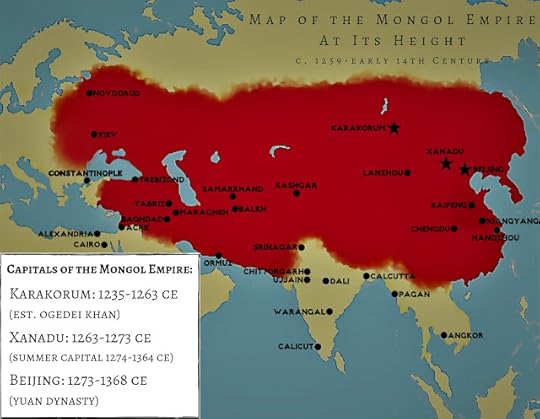 Map of Mongol Empire - World History Encyclopedia
Map of Mongol Empire - World History Encyclopedia The Second Journey to Kublai Khan
In 1271, Niccolò and Maffeo, set off on their second voyage to meet the Great Khan -- this time accompanied by the teenage Marco. They headed to Acre to meet again with the papal legate, Teobaldo Visconti, who was still in the Holy Land. In a remarkable and fortunate turn of events -- after the longest papal vacancy in the history of the Roman Catholic Church -- from 1268 to 1271 -- a new pope was finally elected.
And it was Teobaldo Visconti! Who was as surprised as anyone to receive the news that he had been elected as the new Pope.
Before Visconti left the Holy Land to return to Italy to assume the papal mantle as Pope Gregory X, he gave the Polo Trio the sacred oil from the Church of the Holy Sepulcher, but not the 100 learned Christians requested by Kublai Khan. Instead, they were accompanied by two friars, who did not finish the voyage out of fear. When the Polo Trio arrived in China about four years later, the now 21-year-old Marco Polo met Kublai Khan for the first time. And he was a big hit with the Mongol emperor. Kublai Khan adored the young Venetian and sent him out on diplomatic missions as a foreign emissary throughout this vast empire. The Polos spent about 20 years in China. Apparently Kublai Khan appreciated the Venetians so much that he would not agree to their departure. Around 1295, when he was about 40, Marco finally was able to return to Venice after escorting a Mongolian princess to her betrothed.
To this day, Marco Polo is the symbol of the link between Venice and Asia, West and East. How different would the world be today if the young Venetian had not charmed the exotic ruler of the largest contiguous land empire in the history of the world?
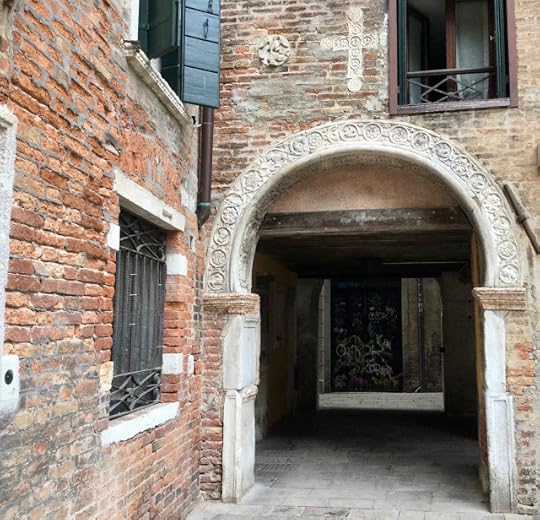 Veneto-Byzantine marble arch, remnants of the Polo family home in Venice - Photo: Cat Bauer
Veneto-Byzantine marble arch, remnants of the Polo family home in Venice - Photo: Cat Bauer6 Venetian Merchants on the 1338 Silk Road Trip
Thanks to Il Milione, for the first time, Europeans got a glimpse into the great wealth of the Mongol Empire. For Venetian merchants, the temptation to tap into the exotic trade of the Eastern world was irresistible. By the end of the 13th century, China -- then called Catai -- had suddenly become reachable thanks to the security of the caravan routes guaranteed by the Mongols.
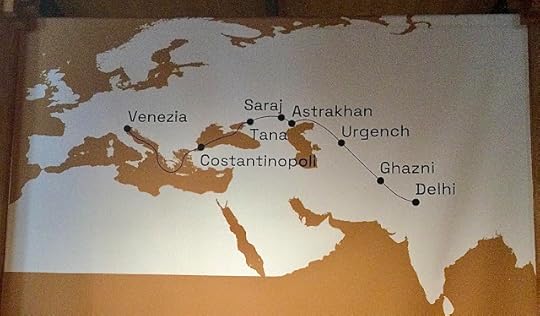 The Itinerary - Photo: Cat Bauer
The Itinerary - Photo: Cat BauerGiovanni Loredan and the societas first stopped in the Byzantine capital of Constantinople, in what is now Istanbul. From there they embarked on four galleys bound for Tana, a commercial emporium on the Sea of Azov at the mouth of the Don. Tana was the most distant emporium of the entire Venetian colonial system, where both Venetian and Genoese merchants had permanent residences. Here is a map of where the ancient territory would be in 2025:
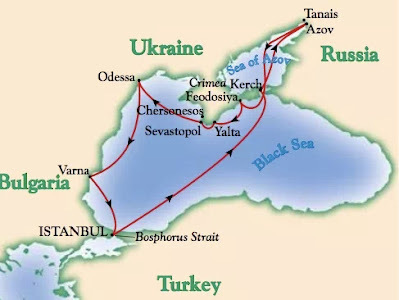 Map at
Map at From Tana, the next stop was Sarai on the Volga river, a thriving metropolis and capital of the Tatar Khanate of the Golden Horde. From Saraj the merchants headed first to Astrakhan, around 55 miles from the Caspian Sea. They waited there for about 50 days before fording the Volga and traveling to Urgench in Uzbekistan -- now an important UNESCO World Heritage archeological site called Old Urgench in Turkmenistan.
Here began the hardest part of the journey. They had to cross the Amu Darya River to reach the Pamir Plateau, known as the Roof of the World, in a range of mountains between Central and South Asia. The Pamir spills over into Kyrgyzstan, Afghanistan, Pakistan, and China.
Where our voyagers were now is so utterly complicated that I will direct you to a site called Big Think that will break it down for you:
The “Roof of the World,” in eight simple lines
Somehow the merchants got down out of the mountains and into Ghazni in Afghanistan at the gates of the Sultanate of Delhi. And there in Afghanistan is why Giovanni Loredan should have listened to his mother, Caterina. Because Giovanni Loredan died in Ghazni and never did meet the Sultan. After several more perilous months, the remaining merchants reached India. The gifts the Venetians brought pleased the Sultan so much that he rewarded the merchants with the fabulous sum of 200,000 Indian coins. The Venetians invested half the money in pearls. On the way back to Venice, another merchant, Boldovino Querini lost his life. The remaining four Venetians made it back to Venice by the end of 1341, having made a substantial return on the initial investment. In 1350, Alberto de Calle sued the heirs of his deceased son-in-law, Giovanni Loredan, for his share of the profit of his investment. The trial involved Giovanni's three sons and his wife, Filipppa, Alberto's own daughter. The court case took place before the Judges of the Procurator, the magistracy that dealt with testamentary matters and the protection of minors.
The Parchment The ancient parchment recording the 1350 trial has arrived to us in the year 2025 thanks to the determination of scholars and their enlightened supporters who are dedicated to the preservation of human nature. It gives us the opportunity to learn from history instead of repeating it.
Honestly, the story told by that parchment gave me goosebumps. Writing and researching this post has been an in-depth history lesson.
Professor Luca Molà said, "This is by far the most detailed document we have on the activities of Venetian merchants in Asia, ranging from China to India and involving the trade of goods from the whole Eurasian continent. The restoration of the parchment has ensured the survival of an extremely valuable cultural asset."
The parchment illustrates the sophisticated and extensive trade networks that existed in the 14th century, connecting Europe with distant regions like China and India. It serves as a powerful reminder that globalization is not a new phenomenon but has deep historical roots.
1338 From Venice to Delhi. Six Merchants on the Silk Roads runs through May 4, 2025. You will find the 1350 parchment in the Museum of Oriental Art on the top floor of Ca' Pesaro, Venice's International Gallery of Modern Art. Museo d'Arte Orientale is home to one of the largest collections in Europe of Japanese art from the Edo period.
Go to 1338 Da Venezia a Delhi. Sei mercanti sulle Vie della seta for more information (in Italian).
Ciao from Venezia,Cat BauerVenetian Cat - The Venice Blog
January 18, 2025
The Wondrous Cabinet of Wonders at Palazzo Grimani in Venice - A Celebration of Art in Nature
 George Loudon discusses his astonishing collection with curator Thierry Morel
George Loudon discusses his astonishing collection with curator Thierry MorelPhoto: Cat Bauer
(Venice, Italy) George Loudon has a whimsical soul and an eclectic mind. I had the chance to chat with the Dutch collector about his astonishing assortment of 19th-century life science artifacts while sipping a Select spritz out in the courtyard of Palazzo Grimani on a chilly winter’s day after the press conference for A Cabinet of Wonders - A Celebration of Art in Nature . The retired investment banker loves living in London and has an endearing curiosity about how life works.
Just when you think all hope is lost and humanity is doomed, you encounter another cluster of creatures of light right here in Venice. George Loudon said he loved being based in London because there were so many things to do. I said I loved being based in Venice because it is a town oozing with art and culture, and everyone who is interesting comes here. “Look where we are right now! Look what you’ve brought with you! How wonderful is that! Thank you so much!”
The George Loudon Collection is unlike anything you've seen before. It's displayed in the majestic piano nobile of Palazzo Grimani like a Darwinian art installation. Handcrafted teaching models -- papier-mâché flowers, taxidermy (there's a two-headed kitten), anatomical specimens, and much more -- are laid out as if they are precious artifacts. It's nature as a work of art.
 Venetian Cabinet - courtesy of Galerie Kugel, Paris
Venetian Cabinet - courtesy of Galerie Kugel, ParisPhoto: Cat Bauer
And that's only half of the exhibition that awaits you at the top of the palace's monumental staircase. Sharing the space is "Mythical Rooms," a recreation of the "Cabinets of Curiosities" or "Wunderkammer" that flourished in the rooms of gentlemen-turned-curators in the 16th and 17th centuries. The space is brimming with rare antiquities, paintings, bronzes, furnishings, and other assorted masterpieces from private collections, galleries, and institutions.
Only human invention can blend these two distinct collections inside Palazzo Grimani to create a singular show like A Cabinet of Wonders: A Celebration of Art in Nature. The exhibition, curated by crackerjack French art historian Thierry Morel, pays tribute to the art of collecting. And Palazzo Grimani sets the scene with the perfect backdrop.
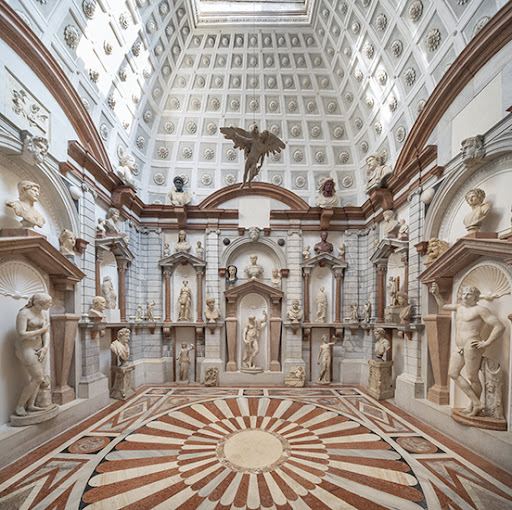 Domus Grimani - Sala della Tribuna inside Palazzo Grimani
Domus Grimani - Sala della Tribuna inside Palazzo Grimani Photo: Venetian Heritage
PALAZZO GRIMANI
Palazzo Grimani was home to some of the most ardent collectors in history. The palace was acquired by Antonio Grimani (1434-1523) in the late 15th century. Antonio would go on to become the 76th Doge of Venice, and the patriarch of a large and powerful family.
One of his grandsons, Giovanni Grimani (1506-1593), the influential Patriarch of Aquileia, enlarged Palazzo Grimani and created the impressive Sala della Tribuna to display the Grimani family's bountiful collection of antiquities. The palace was a Renaissance gem and a magnet for the world's greatest travelers, thinkers, and diplomats.
Palazzo Grimani was the Grimani family home until 1865. As the centuries drifted by and ownership changed hands, the palace slowly slipped into decay. The Italian state acquired the building in 1981 in "deplorable condition." It underwent years of extensive restoration and opened as a public museum in 2008, but there was not much left inside except the phantoms of the past. I wrote a detailed post about it in 2021:
A Brief History of Palazzo Grimani + Domus Grimani & The Room of the Doge
After languishing for years, Palazzo Grimani was brought roaring back to life when Toto Bergamo Rossi, Director of Venetian Heritage, and Daniele Ferrara, Director of the Veneto Regional Directorate for National Museums, curated the stunning Domus Grimani exhibition in 2019. They hauled a load of the original Grimani loot out of the National Archeological Museum in Piazza San Marco and put it back inside Giovanni's Tribuna and the Sala del Doge in Palazzo Grimani where it belonged.
Palazzo Grimani is now part of the National Archaeological Museums of Venice and the Lagoon. The new autonomous institute also includes the National Archaeological Museum of Venice in Piazza San Marco, the Archaeological Park of Altino, and the Archaeological Museum on Lazzaretto Vecchio in the Venice lagoon. The world's first lazaretto, the former quarantine station will transform into the headquarters for the institute, all under the domain of the dynamic new director, Marianna Bressan.
 A Cabinet of Wonders - Installation view
A Cabinet of Wonders - Installation viewCamerino di Callisto - Photo: Cat Bauer
MYTHOLOGICAL ROOMS A Cabinet of Wonders begins in the Sala di Psiche. It's designed to sweep you back to a Renaissance Wunderkammer with paintings, tapestries, sculptures, furniture, and other goodies typical of what you might have found in the Grimani family home.
Giovanni Grimani's private apartment was likely comprised of the Camerino di Callisto and the Camerino di Apollo. The Camerino di Callisto is laid out like a Renaissance scholar's study, as though Giovanni had just stepped out of the room. A never-before-exhibited painting, Christ in Glory, by Paolo Veronese hangs over the fireplace. Lush Rubelli fabrics give the room that lived-in Venetian palace feeling.
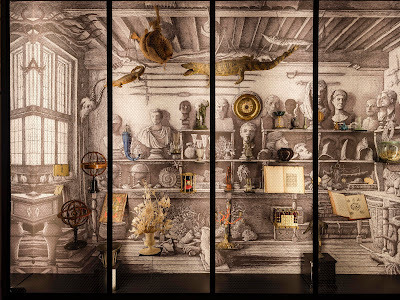 A Cabinet of Wonders - Camerino di Apollo - Installation View
A Cabinet of Wonders - Camerino di Apollo - Installation ViewPhoto: Massimo Listri
Adding to the enchantment, the Camerino di Apollo is decorated with surreal prints by contemporary French artist Erik Desmazières. Weird and wonderful objects like a crocodile stuffed with sawdust are mounted directly onto the prints. It's disorienting and makes you wonder what century you've stumbled into.
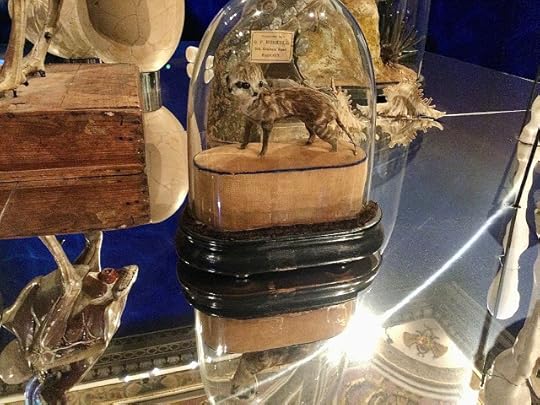 Two-headed kitten, Preserved by G. F. Bushell, 216 Graham Road, HACKNEY
Two-headed kitten, Preserved by G. F. Bushell, 216 Graham Road, HACKNEY George Loudon Collection
Photo: Cat Bauer
THE GEORGE LOUDON COLLECTION
The pièce de résistance of the entire experience is George Loudon's extraordinary collection of 19th-century life science objects.
Loudon has been a collector since childhood, inspired by a fascination with carpentry tools. He began collecting seriously in the late 1970s while working in the banking sector, focusing on young contemporary artists. In 2004, Louden visited Harvard where his daughter's husband was doing his PhD. His daughter took him to see the glass flowers at the Harvard Museum of Natural History. Louden was blown away by the glass flowers created in the late 19th and early 20th centuries by Dresden glass artist Leopold Blaschka and his son and apprentice, Rudolf Blaschka.
The Blaschkas had a thriving business making glass models of marine invertebrates before they turned to flowers. Harvard was a world center for the study of botany, but dried and pressed specimens were difficult to use as accurate teaching tools. The realistic glass botanical models crafted by the Blaschkas solved the problem. According to Wikipedia: "Over the course of their collective lives, Leopold and Rudolf crafted as many as ten thousand glass marine invertebrate models and 4,400 botanical models, the most famous being Harvard's Glass Flowers."
 Pomegranates - George Louden Collection
Pomegranates - George Louden Collectiondidactic models attributed to Francesco Garnier Valletti
Late 19th-century - wax, pigments
Photo: Matteo De Fina
That started Louden out on his quest to collect teaching materials crafted by artisans in the 19th century. It took him several years to realize that he was gathering visual 19th-century science, which became the theme of his collection. The hunt is part of the thrill. Louden finds didactic objects in flea markets and junk shops and the storage rooms of university museums. He's got boxes of Italian wax plants and fruit -- deformed lemons and peaches -- which were used at an agricultural college to teach students about imperfections in horticulture.
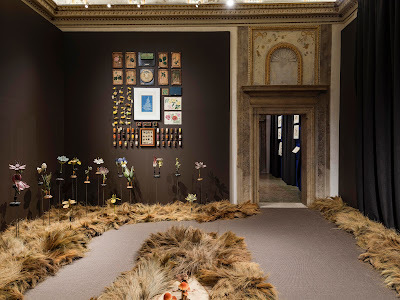 A Cabinet of Wonders - Installation View
A Cabinet of Wonders - Installation ViewPhoto: Massimo Listri
Louden remembers where he found every object, and speaks with affection about each one. There are no labels or descriptions; you must examine each piece and let your imagination wander. The collection is a tribute to the artistry and ingenuity of the creators of the objects.
It took me some time to realize that I was seeing two separate chapters of the same exhibition. One section of The Cabinet of Wonders flows seamlessly into the other. Curator Thierry Moral sums it up: "These two sections, while distinct, mirror and engage with one another, creating a dialogue that invites reflection on the art and practice of collecting."
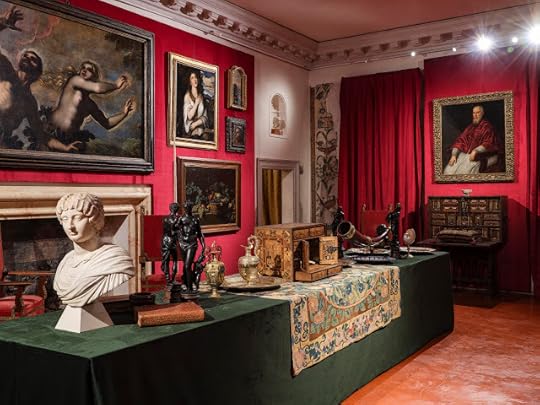 A Cabinet of Wonders - Installation View
A Cabinet of Wonders - Installation ViewPhoto: Massimo Listri
Afterwards, I spoke to Toto Bergamo Rossi, the Director of Venetian Heritage and a mighty force behind much of the movement of art and culture in Venice, especially Palazzo Grimani. I told him I remembered how barren and empty Palazzo Grimani seemed when it first opened as a museum in 2008, and how exciting it was to see it filled with life again.
"I'm sure you have made Giovanni Grimani very happy," I said.
Toto smiled. "I speak to him every night." A CABINET OF WONDERS. A Celebration of Art in Nature. The George Loudon Collection at Museo di Palazzo Grimani runs through May 11, 2025, and is curated by Thierry Morel. The exhibition is promoted by the Italian Minister of Culture, the Musei archeologici nazionali di Venezia e della Laguna, Musei Italiani, Venetian Heritage, and the Loudon Collection in collaboration with Scuola Grande Arciconfraternita di San Rocco. The main sponsor is Viking. Go to Venetian Heritage for more information in English.
Ciao from Venezia,Cat BauerVenetian Cat - The Venice Blog
December 31, 2024
Happy New Year! It's Sunshiny & Bright in Venice on the Last Day of 2024
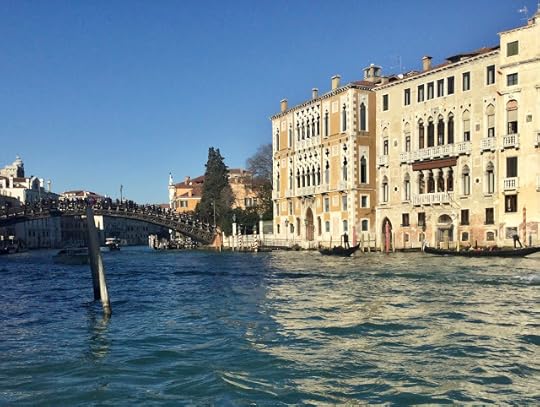 The Accademia Bridge on the Grand Canal
The Accademia Bridge on the Grand Canalon New Year's Eve Day 2024
Photo: Cat Bauer
"Be at war with your vices, at Peace with your neighbors, and let every New Year find you a better man." ---Benjamin Franklin
"Learn from yesterday, live for today, hope for tomorrow."---Albert Einstein "Onward!"---Cat Bauer Have a Happy, Hallowed, Healthy, Harmonious New Year!
Ciao from Venezia,Cat BauerVenetian Cat - The Venice Blog
November 30, 2024
6 Italian National Museums in Venice that Are Free on the First Sunday of Each Month
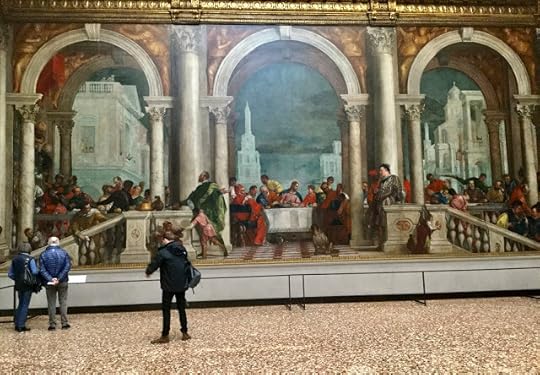 Feast in the House of Levi by Paolo Veronese at Gallerie dell'Accademie, Venice
Feast in the House of Levi by Paolo Veronese at Gallerie dell'Accademie, VenicePhoto: Cat Bauer
(Venice, Italy) Venice is rich with museums and galleries, both public and private, municipal and state. Some say that the town of Venice itself is like strolling through a museum, with some of the most powerful architecture and monuments on Earth dotting the landscape.
There are 11 Civic Museums that fall under the umbrella of the Fondazione Musei Civici di Venezia (MUVE), a foundation whose founding member is the Venice Comune.
Then there are private museums like the Peggy Guggenheim Collection, and the Pinault Collection's Palazzo Grassi and Punta della Dogana — always exciting, with dazzling exhibitions of contemporary art. There are foundations like Fondazione Cini and Fondazione Querini Stampali brimming with treasures. There are works of art in all the churches. Even Venice's local hospital is an ancient architectural masterpiece.
But there are also a handful of museums in Venice overseen by the Italian Ministry of Culture, the branch of the State government in charge of national museums. Throughout Italy, these museums are free to the public on the first Sunday of every month.
Figuring out which museums in Venice are operated by the Italian State and where they are located can be challenging. Here's some help:
ITALIAN NATIONAL MUSEUMS IN VENICE FREE ON THE FIRST SUNDAY OF EACH MONTH
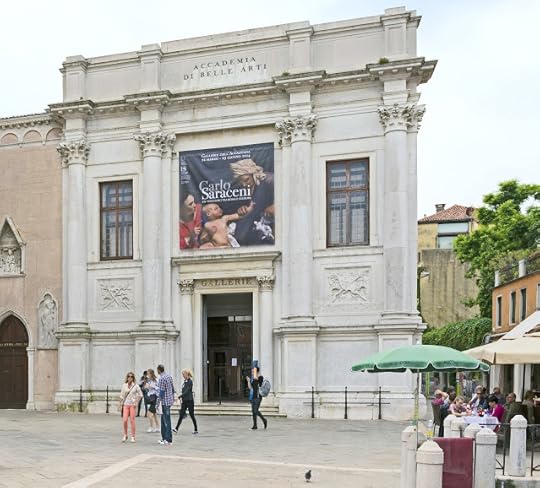 Gallerie dell'Accademia in Venice - Photo: by concession of the Ministry of Culture
Gallerie dell'Accademia in Venice - Photo: by concession of the Ministry of Culture1. Gallerie dell'Accademia - Perhaps the best known of all the national museums, the Gallerie dell'Accademia is located right at the foot of the Accademia Bridge on the Dorsodoro side. It's packed with masterpieces of Venetian painting up to the 19th century by artists such as Titian, Tintoretto, and Veronese. An entire section is devoted to Canova. Leonardo da Vinci's drawing of the Vetruvian Man is here, but rarely on display because it is so fragile. On free Sundays, I have seen the line to enter stretch far down the block, so plan to get there early.
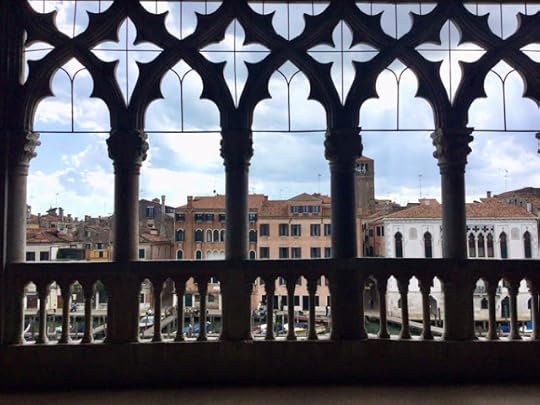 Giorgio Franchetti Gallery at the Ca' d'Oro on the Grand Canal - Photo: Cat Bauer
Giorgio Franchetti Gallery at the Ca' d'Oro on the Grand Canal - Photo: Cat Bauer
2. Giorgio Franchetti Gallery at the Ca' d'Oro - Ca' d'Oro, or Palazzo Santa Sofia, is an elegant, distinct palace in Cannaregio on the Grand Canal. It's one vaporetto stop past the Rialto Market on the other side of the canal. Ca' d'Oro means "House of Gold." Built in 1428, it is the best surviving example of Venetian Gothic architecture. The last owner, Baron Giorgio Franchetti, bequeathed his considerable art collection along with his palace to the Italian State in 1916. The view of the Grand Canal from the loggia is impressive, and the floor of the courtyard is astonishing.
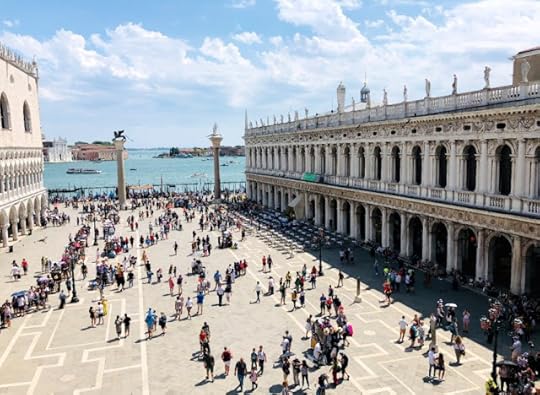 Marciana Library on right - Photo: Veneto.Info
Marciana Library on right - Photo: Veneto.InfoIn St. Mark's Square, things start to get complicated. Both the gilded monumental rooms of the Marciana Library designed by Jacopo Sansovino, and the Archaeological Museum, are national museums under the supervision of the Italian State. Both are located in Piazza San Marco in the enormous buildingthat faces the Doge's Palace and then turns the corner at the Campanile and becomes the Procuratie Nuove.
However, to enter both, you normally have to go through the Correr Museum far down at the other end of Piazza San Marco in the Napoleonic wing, the structure that faces St. Mark's Basilica. The Correr is a Venetian municipal museum under the umbrella of the Venice Civic Museums (MUVE). It is not part of the Italian Ministry of Culture. It is run by Venice. Therefore, it is not free on the first Sunday of the month.
However, during normal operations, the Marciana Library and the Archaeological Museum are included in the price of the ticket you pay to enter the Correr Museum because the layout is such that you can walk right through them all of them. But not on the first Sunday of the month!
The Italian Minister of Culture is very clear:
“Domenica al museo”: free admission to the National Archaeological Museum of Venice and Monumental Rooms of Marciana Library (NOT Museo Correr) for everyone on the first Sunday of each month.
If you think Italian bureaucracy is convoluted, just imagine when it’s layered with an extra labyrinth of Venetian bureaucracy.
So, what are you supposed to do? Luckily, both the Marciana Library and the Archaeological Museum also have their own separate entrances, which are normally closed to the public. They are open on the first Sunday of each month. To put it in language the average person can understand (coffee), the entrance to the Marciana is on the Caffè Chioggia side. The entrance to the Archaeological Museum on the Caffè Florian side.
 Reading room of the Biblioteca Nazionale Marciana
Reading room of the Biblioteca Nazionale MarcianaPhoto: Wikipedia
3. Monumental rooms of the Biblioteca Nazionale Marciana - One of the earliest public libraries on the planet, the Marciana was founded in 1468 when the humanist scholar Cardinal Bessarion donated his collection of Greek and Latin manuscripts to Venice. However, it took Venice some time to build the library, which was designed by Jacopo Sansovino and constructed between 1537 and 1588.
In addition to paintings by Titian, Tintoretto and Veronese, you can see Fra Mauro's large, original 1450 map of the world, and the last will and testament of Marco Polo, dated January 9, 1323 M.V. (according to the Venetian calendar that would be 1324).
When you first enter the vestibule, look up. On the ceiling, you will see one of my very favorite paintings, Wisdom by Titian.
 National Archaeological Museum of Venice - Photo: Joan Porcel
National Archaeological Museum of Venice - Photo: Joan Porcel4. National Archaeological Museum of Venice - Surprisingly, the Ministry of Culture website for the Archaeological Museum is very clear and in English, a rarity, so you can read it yourselves. However, the history of the collection is completely convoluted, shuffling enormous, ancient, heavy statues from Rome to Venice and then all over the place.
Let's start with this: the collection was first established in 1523 by Cardinal Domenico Grimani, and contains ancient Greece and Roman statues, as well as coins, relics, marbles and busts.
We'll continue the story of the Archaeological Museum and the ancient sculptures over at Italian museum No. 5, Palazzo Grimani.
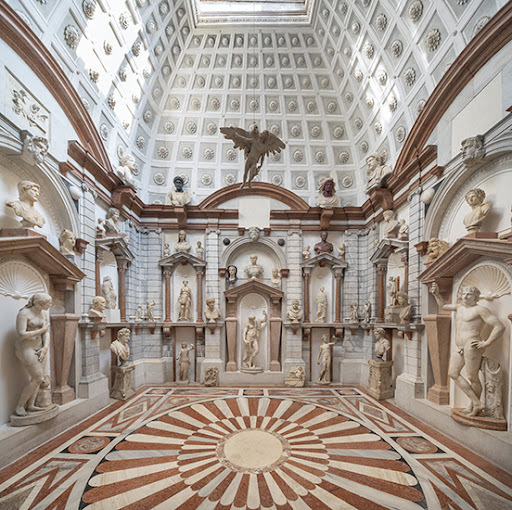 Domus Grimani - Sala della Tribuna at Palazzo Grimani - Photo: Venetian Heritage
Domus Grimani - Sala della Tribuna at Palazzo Grimani - Photo: Venetian Heritage5. Museo di Palazzo Grimani - In 2021, I spent a consider amount of time trying to unravel the history of the Grimani family and what was going on over at Palazzo Grimani. Where did the sculptures come from in the first place? How did ancient Greek and Roman statues end up in Venice? Who was the very important Grimani family? To me, the clearest answers to those questions are in my post:
A Brief History of Palazzo Grimani + Domus Grimani & The Room of the Doge (+ Georg Baselitz Does Double Duty in Venice)
Palazzo Grimani is right off Campo Santa Maria Formosa, about a 10 minute walk from Piazza San Marco. Make the trip from the Archeological Museum to the palace to get a fuller understanding of the history, especially because instead of paying €14 to enter, on the first Sunday of the month, it's free.
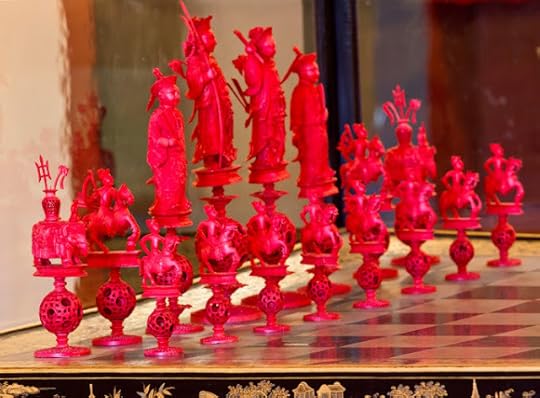 Wood, lacquer & painted ivory Chinese chess set from the 18th century
Wood, lacquer & painted ivory Chinese chess set from the 18th centuryPhoto: by concession of the Ministry of Culture
6. Museum of Oriental Art - Another Italian Ministry of Culture website in English! The Museum of Oriental Art is located on the top floor of Ca' Pesaro, Venice's International Gallery of Modern Art. (That it has such an odd location should no longer surprise us.) This unusual stash from the East is the result of travels taken by Prince Henry of Bourbon-Parma, Count of Bardi to Asia between 1887 and 1889. Prince Henry was a great-grandson of King Charles X of France.
The culmination of Prince Henry’s journeys is one of the most important collections in Europe of Japanese art of the Edo period (1603-1868), with additional sections dedicated to China, Indonesia and South-Eastern Asia.
Prince Henry had no kids, but did own Palazzo Ca' Vendramin Calergi across the Grand Canal from Ca' Pesaro. It's where Richard Wagner died and where the Venice Casino is located.
We can only imagine how the Asian art collection of Prince Henry morphed into an Oriental art museum on the other side of the Grand Canal on the top floor of the modern art museum. But why not?
Ciao from Venezia,Cat BauerVenetian Cat - The Venice Blog



